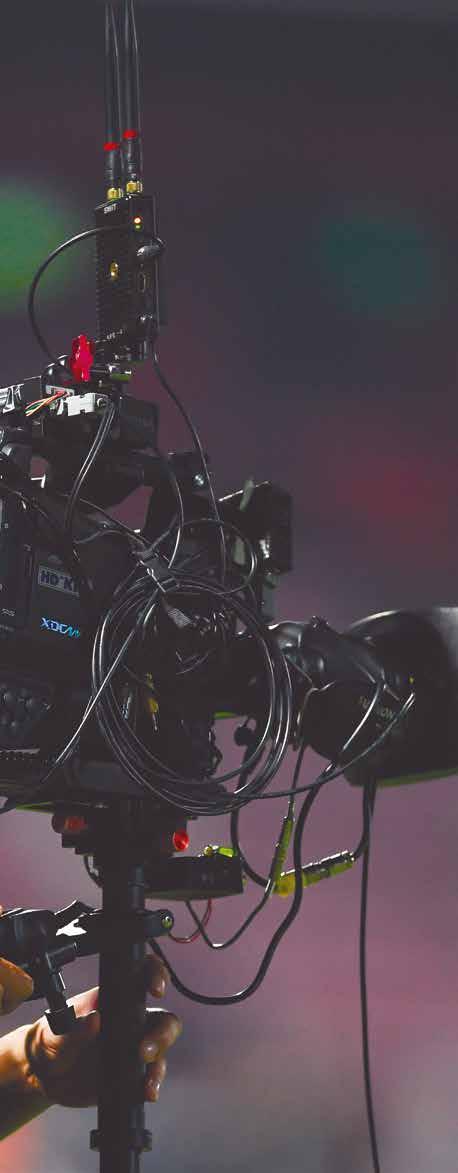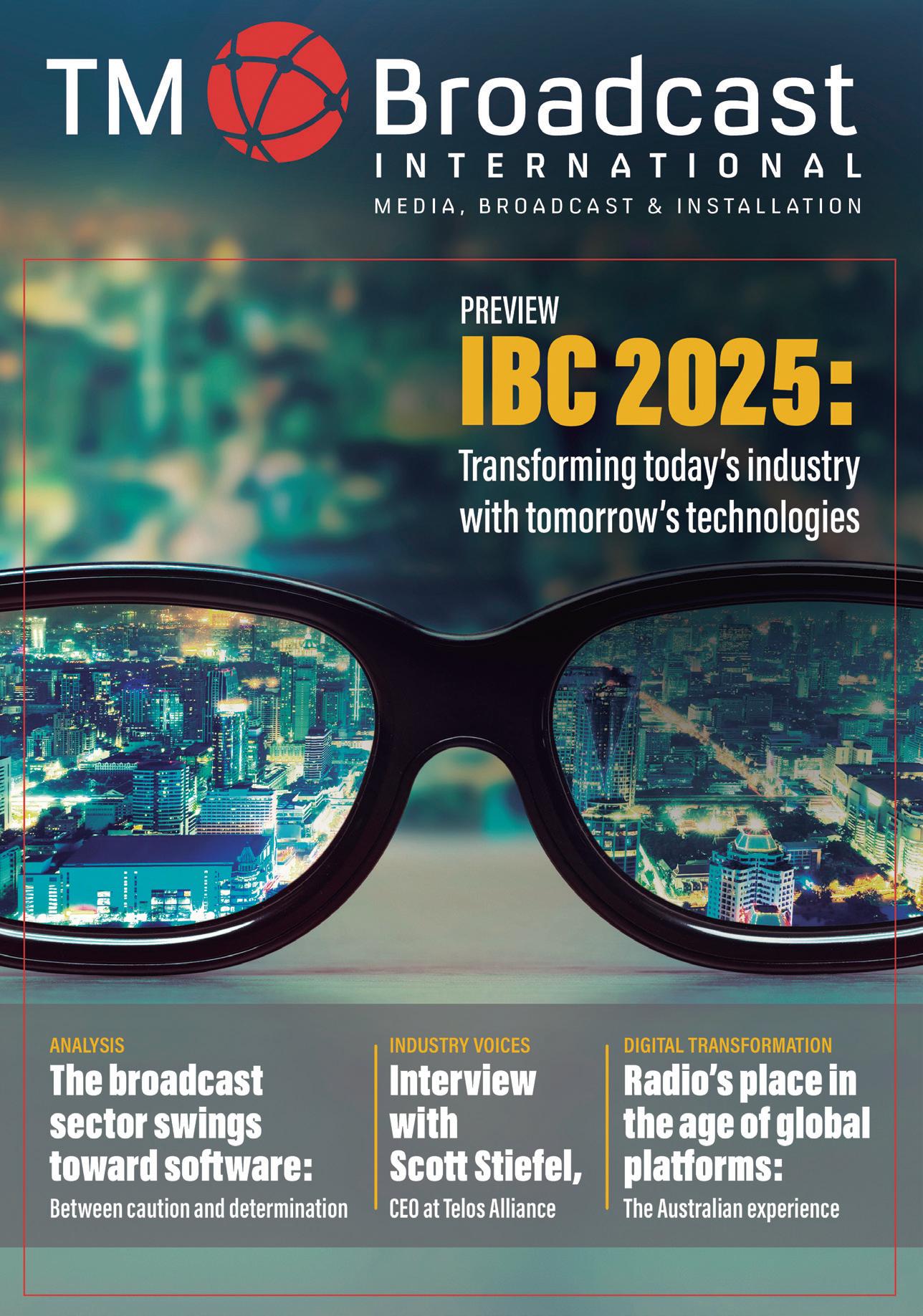CASE STUDIES
› InsideRTVE’s coverageof LaVuelta
› FranceTV takes 5Gtotheskies
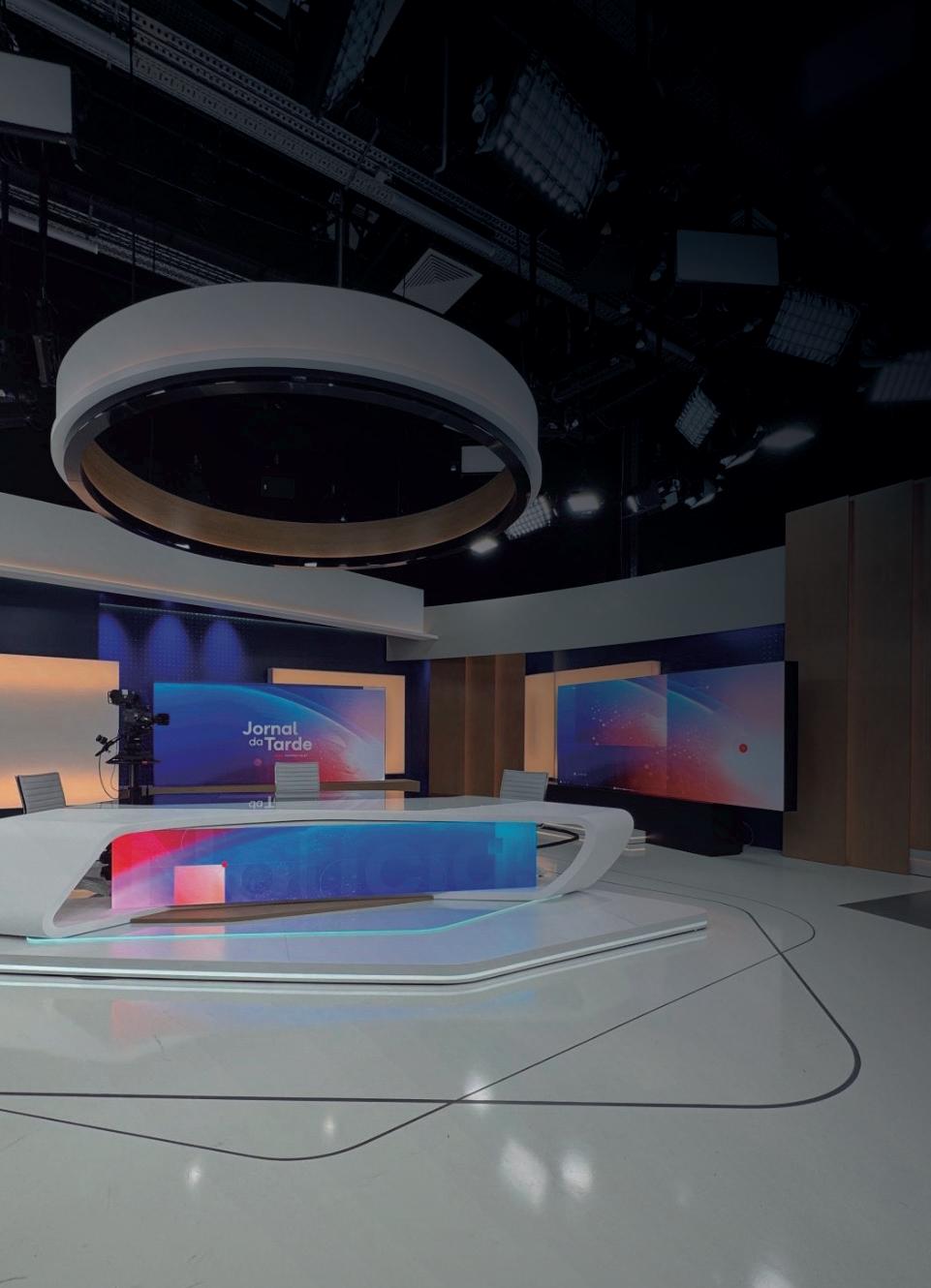
INDUSTRY VOICES Mike Blackman reveals ISE’s roadmapto2027
EXPLAINER Wireless video monitoring inreal time

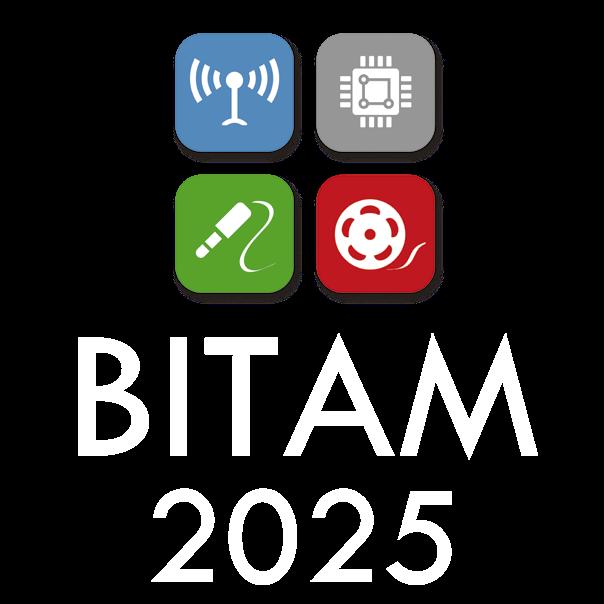

CASE STUDIES
› InsideRTVE’s coverageof LaVuelta
› FranceTV takes 5Gtotheskies

INDUSTRY VOICES Mike Blackman reveals ISE’s roadmapto2027
EXPLAINER Wireless video monitoring inreal time


The convergence between the broadcast and AV worlds is nothing new, yet we are witnessing an acceleration of this process. The boundaries between television production and audiovisual integration are becoming increasingly blurred, giving rise to new models of collaboration and business.
In this context, ISE aims to consolidate its role as a bridge between the two worlds. To gain further insight into its strategy in this regard and obtain a broader view of the show’s evolution, we invited ISE Managing Director Mike Blackman to join our Industry Voices section. The exhibition continues to grow year after year, and in this sense, the executive shares with us —exclusively— his plans to expand the exhibition area ahead of 2027: “We expect to have confirmation within the next few weeks and are optimistic about securing the additional space we need.”
In parallel, this month we turn our editorial focus to Southern Europe, featuring three public broadcasters: Portugal’s RTP, Spain’s RTVE, and France Télévisions.
Editor in chief
Javier de Martín editor@tmbroadcast.com
Creative Direction
Mercedes González mercedes.gonzalez@tmbroadcast.com
Chief Editor
Daniel Esparza press@tmbroadcast.com
Editorial Staff
Bárbara Ausín
Carlos Serrano
The first reveals —exclusively to TM BROADCAST— its upcoming investment plans, which include the creation of a state-of-the-art news centre set to become the nerve centre of the organisation’s information operations. “That’s where we will make a larger investment in technology,” anticipates Monica Cañete Palomo, Director of Engineering and Technological Systems.
As for RTVE and France Télévisions, we present two complementary success stories. In the case of RTVE, we delve into the main technical and operational challenges of its most ambitious project of the year: the Vuelta a España. In the case of France Télévisions, we explore an innovative initiative involving the deployment of a private 5G network integrated into an aircraft, designed to enable live signal transmission from the sky.
Top-level interviews, success stories, trend analysis… all of this —and more— awaits you in this issue, of which this is only a glimpse.
Key account manager Patricia Pérez ppt@tmbroadcast.com
Administration Laura de Diego administration@tmbroadcast.com
TM Broadcast International #147 November 2025
Published in Spain ISSN: 2659-5966
TM Broadcast International is a magazine published by Daró Media Group SL Centro Empresarial Tartessos Calle Pollensa 2, oficina 14 28290 Las Rozas (Madrid), Spain Phone +34 91 640 46 43
20
RTP drives a comprehensive modernisation: towards a more digital, resilient and secure public broadcaster
Portugal’s public broadcaster is advancing through an ambitious technological transformation plan. TM BROADCAST speaks with Monica Cañete Palomo, Director of Engineering and Technological Systems —and a key figure in this process— to review the milestones achieved so far and the road that still lies ahead.

CASE STUDY
Spain’s RTVE at La Vuelta 2025: Inside the technical core of the cycling race
We break down the key technical aspects behind the audiovisual production of Spain’s premier cycling race, based on first-hand information from the country’s public broadcaster.


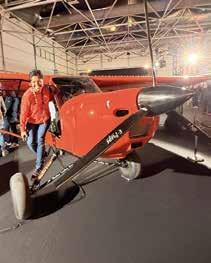
France Télévisions takes 5G to the skies
This initiative represents a step forward in the broadcaster’s exploration of 5G as an enabler for greener, more flexible production models. Amy Rajaonson, Innovation Project Manager at France Télévisions, shares the key highlights.
“We’ll be completely sold out for the 2026 show,” anticipates the Managing Director of Integrated Systems Events. 48
Mike Blackman on ISE’s future: a waiting list and a new temporary structure for 2027
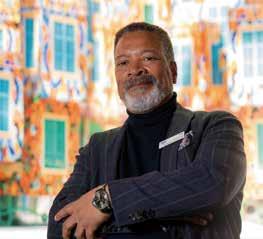

Wireless video monitoring in real time: parameters and specifications for a good choice
The stage of doubts, errors and interferences is well behind us. Wireless video monitoring in real time has become a practically essential, pretty fashionable solution featuring simple configuration and easy operation, which can be summarized in four actions: turn on, pair, transmit and display.

Empresa de Meios Audiovisuais (EMAV) , a technical producer from Portugal and part of the Media Capital Group, has inaugurated its first Virtual Production studio (VP XR) in Lisbon. The complete system has been integrated by VANTeC Danmon Group Portugal, as it has claimed in a statement.
It features a 25×5 meter Alfalite Modularpix
Pro 1.9 ORIM VP XR LED wall and an 8×5 meter Modularpix
Pro 3.9 HB VP XR LED roof, powered by Pixotope’s real-time graphics engine and TrackMen camera tracking systems. This configuration positions the EMAV space as «one of the most advanced virtual production facilities in Europe». It has been designed with the intention of creating hyper-realistic virtual
environments for film productions, series, advertising, video clips and live events.
VANTeC was in charge of the design, integration and implementation of the entire system. The infrastructure, in collaboration with technology partners Alfgalite and Pixotope, aims to offer high technical quality, creative flexibility and efficiency in its operations.
“The Alfalite panels met all our expectations. Color reproduction is precise and uniform across the entire surface, and flexibility in brightness and contrast levels allows us to work with different lighting configurations without compromising quality”, says Jorge Faria, advisor to the General Directorate of EMAV. “The installation process was very quick thanks to the Alfalite
team, and VANTeC’s experience in configuring the entire system was decisive. We finished our first production with excellent results: what would have taken days outdoors was achieved in a fraction of the time inside the studio”.
“We also want to highlight the quality of the entire ecosystem. The reliability of the motors and LED screens left the director of photography and the director very satisfied with the images captured on the virtual set. We have gained a tool that will allow us to save time and maintain total control over each scene that we decide to shoot in virtual”.
“With the implementation of this project, EMAV is now better then ever prepared to face the present and future challenges of content production, both for the internal needs of the Media Capital Group and for the wider market,” says Miguel Oliveira, Managing Director, VANTeC. “We have a solid track record of innovation in audiovisual and broadcast systems integration as a trusted partner in the Iberian market. Our role in creating EMAV’s virtual studio highlights our ability to lead high-complexity projects and deliver solutions that blend technology, efficiency and forward-thinking design. The launch of this studio marks a major step forward for EMAV and the Media Capital Group. It also opens a new chapter in the international recognition
of Portuguese engineering – with VANTeC at the forefront of next-generation audiovisual integration”.
According to Jaime Amores, Product Manager of VANTeC, the EMAV project “it is a clear example of advanced technological integration and collaboration between different systems”. It stands out that “the perfect compatibility of Alfalite LED panels with Pixotope’s rendering and tracking infrastructure, guaranteeing a perfect correspondence between real and virtual elements”.
“From the initial phases, the Alfalite team demonstrated great technical competence and
a collaborative attitude, which greatly facilitated integration. Product reliability and confidence in its technical support were decisive factors”, Amores added about VANTeC’s decision to choose Alfalite.
For Luis Garrido, executive director of Alfalite, the project reflects collaboration and shared knowledge within the European audiovisual industry: “This installation at EMAV is not just about LED technology, but to offer creative professionals a reliable, precise and adaptable tool. The project was made possible thanks to our partner in the Portuguese VP XR market, VANTeC Danmon Group, who
led an exemplary initiative to promote virtual production in the country, together with our trusted collaborators Pixotope, Tangram Solutions and Raised by Monsters”.
“Working hand in hand with these partners and with EMAV was an extraordinary experience, and we are proud to see our screens contributing to Portugal’s growing leadership in next-generation audiovisual production”.
“This virtual studio is more than just a technological investment – it is a commitment to the future of Portugal’s audiovisual industry, with a global outlook”, concludes Nuno Mendonça, Technical Director of EMAV.
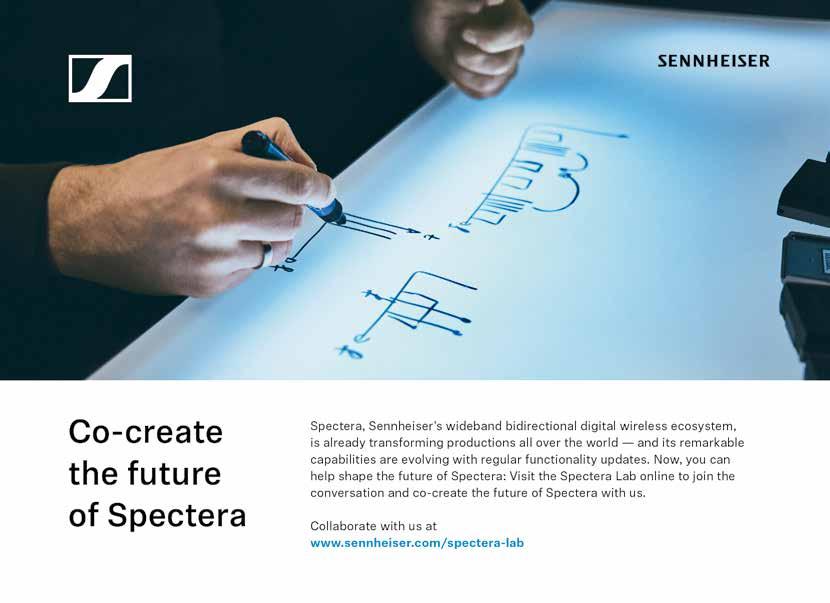
Following the success of the FIFA Club World Cup 2025, FIFA and DAZN are joining forces to relaunch FIFA+ next year on DAZN, as the companies have claimed in a statement.
The new “Global Home of Football” platform on DAZN will launch in 2026 and aims to deliver a personalised experience for football fans all across the world, tailored to their individual preferences.
Building on the existing FIFA+ service, it will combine live and on-demand football content, highlights and exclusive behind-the-scenes access from more than 100 men’s and women’s national teams and club leagues. Additionally, a multichannel news service will be offered in multiple languages. The schedule will look to comprise hourly news capsules, a weekly analysis show and on-demand content such as documentaries, interviews, and series.
Fans will be able to access the new FIFA+ platform for free. The freemium version will be available across the globe, with the option to pay for additional premium content. It is designed to offer the latest goals, dive into in-depth statistics and news, or connect with fellow supporters through influencer-created content and grassroots stories.
The FIFA+ platform will be available the year of the next FIFA World Cup, looking forward
to celebrate football’s spirit and passion. It will ensure that access is available to even more fans worldwide than before.
Mattias Grafström, FIFA
Secretary General, expalined: “In a short period of time, the partnership between FIFA and DAZN has proven to be a remarkably successful one, as witnessed through the record-breaking FIFA Club World Cup tournament in the United States earlier this year. Pushing the boundaries of innovation is clearly something we excel at together and partnering with DAZN, FIFA is delighted to bring even more football content – and a wider variety of experience, excitement and entertainment – to fans worldwide through the new FIFA+ platform”.
Shay Segev, DAZN Group CEO, added: “Our new global football platform marks a significant milestone in our successful partnership with FIFA, and is an exceptional addition to DAZN’s extensive portfolio of premium football content. From next year, millions of fans around the world will be able to enjoy even more top-tier football content for free on FIFA+ on DAZN. The new platform will elevate DAZN’s offering of the world’s best leagues and competitions, such as the UEFA Champions League, Serie A, Bundesliga, Ligue 1, and the Premier League. This launch is a game-changing step forward for DAZN and FIFA to combine their scale, technology, content and partnerships for the benefit of fans and partners across the globe”.


EA Sports and the National Football League have announced a multi-year exclusive agreement with the objective of growing American football worldwide. This partnership is the most comprehensive one to date between EA Sports and the NFL, as they have claimed in a statement.
Both of them will keep on working on driving innovation and expansion of the Madden NFL franchise, which will continue as the exclusive action simulation game for NFL football. The collaboration will also support new content and experiences in EA Sports College Football, as well as new largescale interactive experiences for football fans, built around
community, social connection, self-expression and gameplay.
“EA Sports and the NFL have built one of the most iconic partnerships in all of sports and entertainment, and we see so much opportunity ahead to deliver for football fans everywhere”, affirmed Cam Weber, president of EA Sports.
“With more than 2 billion games of Madden NFL played each year, the global community of football fans connecting through play has never been bigger. Together with the NFL, we will continue to shape the interactive future of football – expanding Madden NFL, growing College Football, and creating new breakthrough experiences for the next generation of fans”.
“Madden NFL has become one of the most widely recognized and culturally relevant gaming franchises in the world”, noted Renie Anderson, executive vice president and chief revenue officer at the NFL. “As we look to this new chapter in our partnership with EA Sports, our focus remains on the success of NFL simulation gameplay and providing our fans with the best entertainment and experiences around the sport they love”.
Looking ahead, EA Sports and the NFL aim to create a more expansive world of interactive football experiences, where fans can play, watch, create and connect. Beyond the games, new experiences like EA Sports Madden NFL Cast are delivering immersive ways for fans to engage with an NFL gameday broadcast. To further fuel fandom globally, EA Sports served as presenting sponsor of the 2025 NFL Dublin game and NFL Experience Dublin and will also expand the Madden NFL Championship Series (MCS) to a global audience with the first-ever MCS competition in Spain alongside the 2025 NFL Madrid game.
At the core of EA Sports’ American football portfolio, multi-year investments in machine learning, real-world data integration, volumetric capture and AI are powering the next generation of play.

ITV has agreed a new deal with FIFA to broadcast the FIFA U-17 World Cup Qatar 2025, marking the first time the tournament will be shown on ITV, as it has claimed in a statement.
The agreement includes coverage of all three of England’s group stage matches, with select fixtures from the knockout stages to be broadcast free-to-air across ITV4 and ITVX.
The first match, head to head with Venezuela, will broadcast exclusively on ITV4 and ITVX, Thursday 6th November, at 15:00.
ITV’s remaining fixtures for the FIFA U-17 World Cup 2025 include:
› Friday 7th November 12:15 –England v Haiti
› Monday 10th November 15:30 –England v Egypt
Niall Sloane, ITV Director of Sport, stated: “This deal marks the first time ITV has broadcast the FIFA U-17 World Cup and we are pleased to continue our relationship with FIFA ahead of next year’s FIFA World Cup 2026. The tournament will showcase the very best in young footballing talent and will highlight future superstars of the game”.
The tournament began in Qatar on 3rd November and the Final will be played on 27th November,
featuring 48 nations competing across twelve groups. A total of 104 matches will be played across eight pitches within the Aspire Zone Competition Complex, culminating with the Final on 27 November at Khalifa International Stadium. The expanded format welcomes five nations making their FIFA U-17 World Cup™ debut: Fiji, Republic of Ireland, Zambia, El Salvador and Uganda. Qatar will be looking to improve on their best finish, when they claimed fourth place in the 1991 edition of the tournament that took place in Italy – becoming the first Qatari team to reach the Third-Place Playoff.
Further details regarding the select fixtures from the knockout stages will be announced in due course.
Companies and organizations from the sports and audiovisual ecosystem have sent a letter addressed to Henna Virkkunen, Executive Vice-President of the European Commission for Technological Sovereignty and Security, and to the Commissioner for Youth, Culture and Sport, Glenn Micallef, urging
the adoption of legislative, binding, and result-driven measures.
The letter stress that the fight against audiovisual fraud requires collaboration and legislative support, especially since voluntary measures and private enforcement are no longer sufficient and legal mechanisms have been outpaced by the speed and sophistication of pirate networks and services, as the signatories have claimed in a statement.
“While we acknowledge the important work undertaken by the European Commission in addressing this challenge through the 2023 Recommendation
on combating online piracy of sports and other live events, its implementation has yet to deliver tangible results. We therefore look forward to seeing further legislative steps being taken to achieve the objectives set out in the Recommendation”, explains the document.
The CEOs/Leaders of organisations ask for the introduction of legislative measures to:
1. Ensure that, upon receipt of a notice, infringing content is taken down as near to immediately as is possible and in all cases within a maximum time frame of 30 minutes. The urgency of live event piracy justifies a far shorter timeframe which is further supported by the fact that such removal can already be effected in a significantly shorter timeframe using the technology solutions available today.
2. Ensure EU-wide live dynamic blocking orders (including IP blocking) that address mirror sites and successor domains are made available in all Member States.
3. Ensure intermediaries (including but not limited to platforms, hosts, VPN, CDN and app stores) introduce and maintain robust Know Your Business Customer (KYBC) policies.
In addition, they also call for “the comprehensive enforcement of the Digital Services Act and on national Digital Services Coordinators to award private bodies such as those we represent the Trusted Flagger status when requested”.
The document was shared by the “Association of Commercial Television and Video on Demand Services in Europe”. You can access the full letter here.
The 36 signatories are:
1. ACT
2. AMC Networks International
3. ATP Media
4. beIN Media Group
5. CANAL+
6. CME Group
7. DAZN
8. DFL Deutsche Fussball Liga
9. DPG Media
10. Euroleague Basketball
11. European Arenas Association
12. European Leagues
13. FriendMTS
14. Lega Calcio Serie A
15. LFP Media
16. Liga nacional de fútbol profesional de España
17. London Marathon Group
18. MFE-MEDIAFOREUROPE
19. Mediastalker
20. Nagravision
21. Paramount
22. Pearle* – Live Performance Europe
23. PGA European Tour
24. Premier League
25. PSE Belgium
26. The R&A
27. RTL Group
28. Sky Group
29. Scottish Professional Football League
30. TF1 Group
31. The Walt Disney Company
32. UNI Europa – Media, Entertainment and Arts
33. United Media
34. Verimatrix
35. Viaplay Group
36. Warner Bros Discovery Sports Europe


Apple and Formula 1 have announced a five-year partnership that will bring all F1 races exclusively to Apple TV in the United States beginning next year, as they have claimed in a statement.
The partnership builds on Apple’s relationship with Formula 1 following Apple Original Films’ blockbuster F1 The Movie. To try to offer fans new experiences, the partnership looks forward to setting the stage for Formula 1’s growth in the U.S.
Apple TV will deliver coverage of Formula 1, with all practice, qualifying, Sprint sessions, and Grands Prix available to Apple TV subscribers. Select races and all practice sessions will also be available for free in the Apple TV app throughout the course of the season. In addition to broadcasting Formula 1 on Apple TV, Apple will amplify the sport across Apple News, Apple Maps, Apple Music, and Apple Fitness+. Apple Sports — the free app for iPhone — will feature
live updates for every qualifying, Sprint, and race for each Grand Prix across the season, with realtime leaderboards, season driver and constructor standings, Live Activities to follow on the Lock Screen, and a designated widget for the iPhone Home Screen.
F1 TV Premium, F1’s own premier content offering, will continue to be available in the U.S. via an Apple TV subscription only and will be free for those who subscribe.
“We’re thrilled to expand our relationship with Formula 1 and offer Apple TV subscribers in the U.S. front-row access to one of the most exciting and fastestgrowing sports on the planet”, affirmed Eddy Cue, Apple’s senior vice president of Services. “2026 marks a transformative new era for Formula 1, from new teams to new regulations and cars with the best drivers in the world, and we look forward to delivering premium and innovative fan-first coverage to our customers in a way that only Apple can”.
“This is an incredibly exciting partnership for Apple and the whole of Formula 1 that will ensure we can continue to maximize our growth potential in the U.S. with the right content and innovative distribution channels”, noted Stefano Domenicali, Formula 1’s president and CEO. “We are no strangers to each other, having spent the past three years working together to create F1 The Movie, which has already proven to be a huge hit around the world. We have a shared vision to bring this amazing sport to our fans in the U.S. and entice new fans through live broadcasts, engaging content, and a year-round approach to keep them hooked. I want to thank Tim Cook, Eddy Cue, and the entire Apple team for their vision and passionate approach to delivering this partnership, and we are looking forward to the next five years together”.
Additional information — including production details and product enhancements — will be announced in the coming months.
F1 The Movie will make its global streaming debut on Apple TV on Friday, December 12, 2025. Hailing from Apple Studios, it is directed and produced by Jerry Bruckheimer, Kosinski, seventime Formula 1 world champion Lewis Hamilton, Pitt, Dede Gardner, Jeremy Kleiner, and Chad Oman.
the time, according to an EBU study
New research coordinated by the European Broadcasting Union (EBU) and led by the BBC has found that AI assistants – already a daily information gateway for millions of people – routinely misrepresent news content no matter which language, territory, or AI platform is tested, as they have claimed in a statement.
The international study was launched at the EBU News Assembly, in Naples. Involving 22 public service media (PSM) organizations in 18 countries working in 14 languages, it identified multiple systemic issues across four leading AI tools.
Professional journalists from participating PSM evaluated more than 3,000 responses from ChatGPT, Copilot, Gemini, and Perplexity against key criteria, including accuracy, sourcing, distinguishing opinion from fact, and providing context.
› 45% of all AI answers had at least one significant issue.
› 31% of responses showed serious sourcing problems – missing, misleading, or incorrect attributions.
› 20% contained major accuracy issues, including hallucinated details and outdated information.
› Gemini performed worst with significant issues in 76% of responses, more than double
the other assistants, largely due to its poor sourcing performance.
› Comparison between the BBC’s results earlier this year and this study show some improvements but still high levels of errors.
AI assistants are already replacing search engines for many users. According to the Reuters Institute’s Digital News Report 2025: 7% of total online news consumers use AI assistants to get their news, rising to 15% of under-25s.
“This research conclusively shows that these failings are not isolated incidents”, affirms EBU Media Director and Deputy Director General Jean Philip De Tender. “They are systemic, cross-border, and multilingual, and we believe this endangers public trust. When people don’t know what to trust, they end up trusting nothing at all, and that can deter democratic participation”.
Peter Archer, BBC Programme Director, Generative AI, explained: “We’re excited about AI and how it can help us bring even more value to audiences. But people must be able to trust what they read, watch and see. Despite some improvements, it’s clear that there are still significant issues with these assistants. We want these tools to succeed and are open to working with AI companies to deliver for audiences and wider society”.
The research team have also released a “News Integrity in AI Assistants Toolkit”, to try to help develop solutions to the issues uncovered in the report. It includes improving AI assistant responses and media literacy among users. Building on the extensive insights and examples identified in the current research, the Toolkit addresses two main questions: “What makes a good AI assistant response to a news question?” and “What are the problems that need to be fixed?”.

Channel 4’s Dispatches has become the first British television programme to use an AI presenter – as part of a deliberate on-screen stunt to show just how convincing artificial intelligence has become, and to highlight the speed at which the technology is developing, as it has claimed in a statement.
Airing on Monday 20 October at 8pm on Channel 4, and now available to stream on Channel4 ‘Will AI Take My Job? Dispatches’ investigates how AI automation is reshaping the workplace, pitting humans against machines in a series of real-world tests across medicine, law, fashion and music. But in a twist saved for the end of the film, it’s revealed that the programme’s own presenter, who appears throughout reporting from different locations, was entirely AI-generated.
Throughout the documentary viewers see the presenter appear and narrate the show. Yet in the closing moments, the reveal lands: the “presenter” was entirely AI-generated – their face, voice and movements all created through AI technology, without a single frame of real-world filming. The AI says:
“AI is going to touch everybody’s lives in the next few years. And for some, it will take their jobs. Call centre workers? Customer service agents? Maybe even TV presenters like me. Because I’m not real. In a British TV first, I’m an AI presenter. Some of you might have guessed: I don’t exist,

I wasn’t on location reporting this story. My image and voice were generated using AI”.
The AI anchor was produced by AI fashion brand Seraphinne Vallora for Kalel Productions, using prompts to create a realistic digital human capable of delivering nuanced on-camera performances.
The project aimed to represent a leap in both storytelling and technology, demonstrating the growing accessibility of AI tools that can convincingly replicate human presence on screen.
Channel 4 has clear editorial guidelines governing the ethical use of artificial intelligence. The film complies fully with these, including a commitment to transparency and disclosure to audiences when AI is used. The reveal at the end of the programme ensures viewers understand the purpose of the stunt and the broader public-interest question it raises about trust and authenticity in the digital age.
Louisa Compton, Head of News and Current Affairs, Specialist Factual and Sport at Channel 4, explained: “The use of an AI presenter is not something we will be making a habit of at Channel 4 – instead our focus in news and current affairs is on premium, fact checked, duly impartial and trusted journalism – something AI is not capable of doing. But this stunt does serve as a useful reminder of just how disruptive AI has the potential to be – and how easy it is to hoodwink audiences with content they have no way of verifying”.
Adam Vandermark, Commissioning Editor for News and Current Affairs at Channel 4 added: “Kalel Productions worked hard to make the reporter feel and appear as authentic as possible, but of course AI couldn’t do the work of an investigative journalist. Or could it? It’s far too early to tell, but it’s certainly a revelation to see this imaginary presenter front a Dispatches in such a clever and realistic way”.
International French-language broadcaster TV5Monde has recently undertaken a complete overhaul of its main studio set. This modernisation forms part of a broader initiative to try to refresh the channel’s visual identity and news presentation, as Smode has claimed in a statement.
Driven by Philippe Antoine, appointed news director in March, TV5Monde sought to move away from the traditional globe backdrop in favour of showcasing faces and landscapes. At the core of this new visual identity is Smode, the real-time compositing and media server platform.
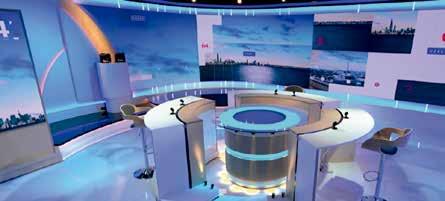
Designed by Panoramic 7, the new set incorporates augmented reality and a fully reimagined visual architecture. Its graphic design, led by Julie Lavigne, features a dominant ember orange palette, with blue tones for news and violet for cultural segments. Nicolas Menet oversaw the title sequence, while agency 17Mars delivered the full graphic package including logo, lower thirds and screen animations.
Integrated directly into the channel’s nodal system, a Smode server now controls all studio screens, the central totem and augmented reality elements.
“The aim of this redesign was also to improve the working environment and comfort for journalists and production teams”, explains Nicolas Renard, director of productions for TV5Monde. To support a smooth transition for studio teams, training was provided by Erwan Tehel, head of training and product specialist at Smode Tech. TV5Monde’s graphics teams now work closely with journalists and the Smode operator, benefiting from an agile, collaborative production workflow that supports more dynamic and human-centred news delivery.
Tatxo Benet, until now Chairman and CEO of Grup Mediapro, is stepping down from his role following an agreement with SouthWind, the group’s majority shareholder. Benet announced his departure to the company’s executive committees and all professionals across the group during a general meeting held at
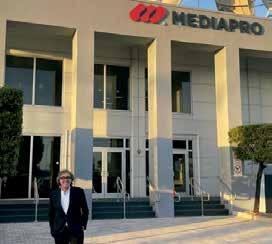
the Barcelona headquarters and streamed live to all other offices.
Reflecting on his departure, Benet stated: “I take with me the experience of the past 30 years, and the immense talent and humanity of the more than 55,000 professionals who have worked at the group. I’m confident that this new chapter —one in which none of the three original founders remain—will be just as successful as the past three decades, which have seen Grup Mediapro, a company born and raised in Catalonia, become a global benchmark”, as the company has claimed in a statement.
Benet began his career in journalism, contributing to media outlets such as Diario de Lérida, El País, and El Periódico de Catalunya. He was a founding member of Televisió de Catalunya (TVC), where he was appointed Head of Sports in 1987, a role he held concurrently as Sports Coordinator for FORTA. He led the television production of the Barcelona 1992 Olympic Games and served as Director of the Olympic Channel. In 1997, he was named Managing Director of Audiovisual Sport, and in 2000, he co-founded Mediapro alongside Jaume Roures and Gerard Romy.
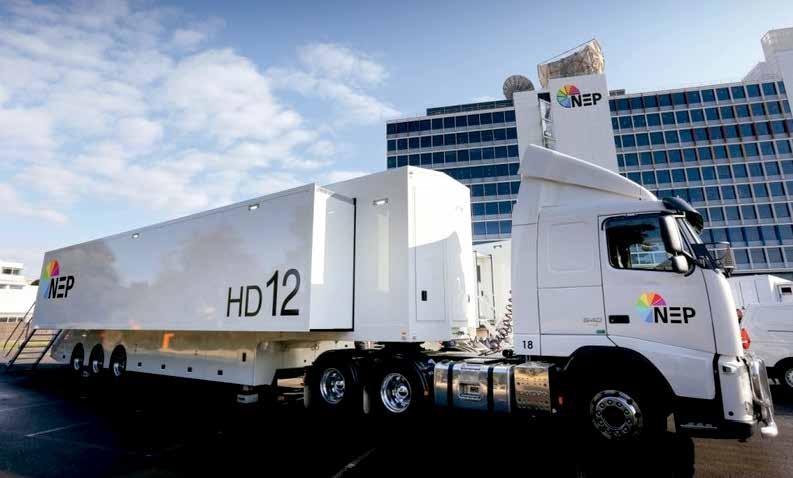
NEP Group has announced a new equity investment in the company led by 26North Partners LP (26North), together with a group of co-investors. Carlyle, NEP’s existing sponsor, is participating alongside 26North in the investment and will remain its largest shareholder, as the company has claimed in a statement.
The platform 26North was founded in 2022 by Josh Harris, who is also the Founder and Managing General Partner of Harris Blitzer Sports & Entertainment and the Managing Partner of the Washington Commanders. This portfolio across sports and entertainment aims to provide a different perspective, aligning closely with
NEP’s position at the intersection of media and live events.
NEP has also completed a debt refinancing, which has enhanced NEP’s capital structure and reduced its debt levels, as it has informed the group.
Martin Stewart, CEO of NEP Group, affirmed: “We’re thrilled to take NEP to the next level with outstanding capital partners at our side. Josh brings exceptional expertise in creating one of the world’s leading sports and entertainment portfolios, and he and the 26North team have a proven track record of growing businesses across industries. We also couldn’t be more pleased to have earned the continued trust and support of Carlyle”.
“We remain committed to investing in our people, technology and dynamic facilities to deliver the innovation, scale and reliability that our clients have relied on for 40 years. We’re beginning our next 40 years with great momentum”.
Mark Weinberg, Head of Private Equity at 26North, added: “We’re excited to work with Martin, his leadership team, and Carlyle to build on the strong foundation they’ve created. NEP represents the kind of business we seek to invest in: a global market leader with a stellar reputation for service delivery, technical expertise and innovation that keeps customers coming back for compelling storytelling around their most important events and experiences”.
Imagine Communications and Rohde & Schwarz have announced a definitive agreement under which Imagine will acquire Pixel Power Limited, a wholly owned subsidiary of Rohde & Schwarz. The acquisition is expected to close in 2025 and is subject to customary closing conditions, as the cmpanies have claimed in a statement.
The transaction has the objective of enabling Imagine to offer broadcast customers extensive portfolio of live production and playout solutions on the market while allowing Rohde and Schwarz to focus on its core operations in Test & Measurement, Technology Systems, and Networks & Cybersecurity.
Imagine and Pixel Power have a shared vision for the IP- and cloud-based future of broadcast and digital streaming markets. This acquisition tries to broaden Imagine’s live production
ecosystem and playout offerings via integration of Pixel Power’s software-defined, deployanywhere platforms.
The addition of Pixel Power’s Prismon multiviewer, which delivers control and cloud capabilities, will focus on complementing the ultra-lowlatency production capabilities of Imagine’s popular SNP Multiviewer and enable Imagine to offer IP and IP-hybrid multiviewer solutions available on the market.
Additionally, Imagine has the intention of maintaining Pixel Power’s Cambridge facility, combining the existing support with its renowned care and services team, and supporting all current global customers and the installed base for Pixel Power’s Prismon, Gallium and StreamMaster platforms.
“We are proud of the achievements of Pixel Power, and we are confident that

Imagine is the right home for their continued growth and expansion”, affirmed Thorsten Sauer, CEO of Pixel Power and VP Media Solutions of Rohde & Schwarz. “This move allows us to focus more deeply on our core operations and customer base while ensuring that we pass the reins to a new owner who cares deeply about our customer base and will take the business to the next level”.
“We’re excited to welcome the talented Pixel Power team to the Imagine family”, noted John Mailhot, Senior Vice President, Product Management, at Imagine Communications. “This acquisition enhances our ability to deliver innovative, business-driving solutions for our customers, and we’re proud to continue building on the strong foundation established under Rohde & Schwarz”.
“This alignment not only opens up exciting new opportunities to scale our innovation, but also ensures customers benefit from more tailored solutions, improved support, and a stronger foundation for evolving workflows”, added James Gilbert, Deputy CEO of Pixel Power.
“Our team is energized by the possibilities ahead and ready to help in shaping the next chapter of broadcast technology”.
Imagine Communications will be demonstrating Pixel Power products for the first time at NAB NY 2025 (Oct. 22-23, Javits Center, NYC, Booth #137).
The 2025 NAB Show New York concluded at the Javits Center after two days of sessions, exhibits and debate about where media is headed next. This edition drew 11,500 registered attendees from 95 countries, roughly 10% of them came from outside the U.S., and 62% were first-time participants, as it has claimed in a statement.
Although the number of attendees has experienced a decrease since 2023 (where registered attendance reached 12,231, and in 2024 dropped to 12,000), the show featured 260 exhibitors and sponsors, including 51 first-time companies, a few more than in the last edition.
“NAB Show New York 2025 showcased the creative forces transforming media right now”, affirmed Karen Chupka, executive vice president of NAB Global Connections and Events. “There’s no better backdrop than New York City — the media and entertainment capital of the world — to bring together this kind of expertise and energy. Across every sector, from broadcasters and filmmakers to creators and technologists, attendees came together to learn, experiment and connect in one of the most dynamic professional communities anywhere”.
The 2025 NAB Show New York aimed to reflect the accelerating evolution of media

and entertainment, showcasing how technology and creativity continue to reshape the industry. Artificial intelligence, the creator economy and new sports-media workflows were among the most visible forces driving innovation across the Javits Center.
This topics where discussed across almost 39,000 square feet of exhibit space. Demonstrations highlighted AI-enabled production and editing tools, workflow automation and data-driven storytelling, alongside live-shopping and creatorcommerce activations that brought platform strategy to life.
“New York is the largest media market in the world. The audience here is everybody you want to speak to”, noted Alex
Sessions focused on how automation and emerging technology are reshaping journalism, production and local broadcasting, while preserving public confidence in trusted news sources. “The Future of Journalism” and related programs explored ethics, policy and revenue strategies for an AI-driven newsroom, accompanied by the release of new NAB data on public attitudes toward AI and media trust.
“Most people — and the data backs this — wildly trust their local broadcaster more than any other type of media. There’s actually a split in their minds
between the mainstream news and their local ‘WTV,’ whatever it is. They trust their local news stations”, explained Sara Fischer, Media Correspondent, Axios
Thursday’s programming turned to the fast-growing creator economy and how platforms, brands and talent
are redefining storytelling, style and partnerships.
“Creator Day” sessions explored audience growth, monetization and authentic collaboration across social and streaming channels — while fashion leaders joined the conversation to examine how digital influence is reshaping brand identity and consumer engagement.
The festivities began the night before the Show’s opening with the Marconi Radio Awards on Oct. 21, honoring excellence across the radio industry and serving as the unofficial kickoff to NAB Show New York. The celebration set the tone for two days of innovation and inspiration that followed at the Javits Center.
Systems integrator Broadcast Solutions is taking a forwardlooking approach and expanding its management team. Effective from 1 November 2025, Stefan Breder continues in his current role as CEO together with Maximilian Breder in a Co-CEO structure. At the same time Zlatan Gavran was appointed COO of the company, as it has claimed in a statement.
Stefan Breder commented: “I am very much looking forward to working closely together with Maximilian as Co-CEOs and I am confident that, together, we will
successfully drive the continued development of the Broadcast Solutions Group. This step marks an important part of shaping our future”.
Stefan Breder continued on Zlatan Gavran’s appointment, “With Zlatan, we have also gained a very experienced industry expert as COO – together we will lead our company successfully into the coming years”.
Gavran is a career leader in media technology, and joins Broadcast Solutions from NEP Germany GmbH. “Throughout

my career – and especially at NEP – I have been a customer of Broadcast Solutions”, said Gavran. “I know just how reliable, innovative and passionate the company is. When the invitation came to join its leadership team I naturally jumped at the chance.”.
Gavran studied for both bachelor and master’s degrees in AV and broadcast technology at Stuttgart Media University. His career has taken him to senior roles in major businesses, culminating in eight years as managing director of NEP Germany.
Alongside the Co-CEOs and Gavran, Rainer Kampe remains as CTO, and Wladislaw Grabowski also retains his senior leadership role as COO. Zlatan Gavran now takes direct responsibility for all broadcast operations, from workflow design and project management to purchasing and quality control.
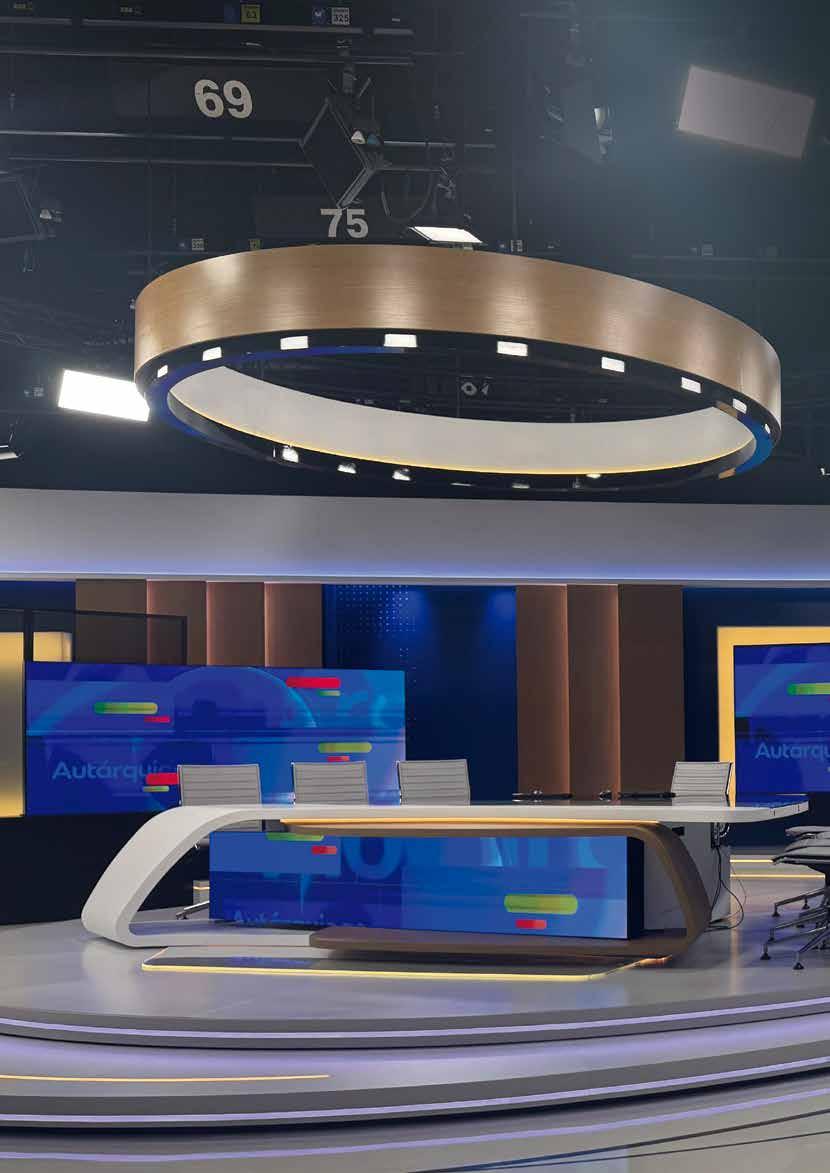
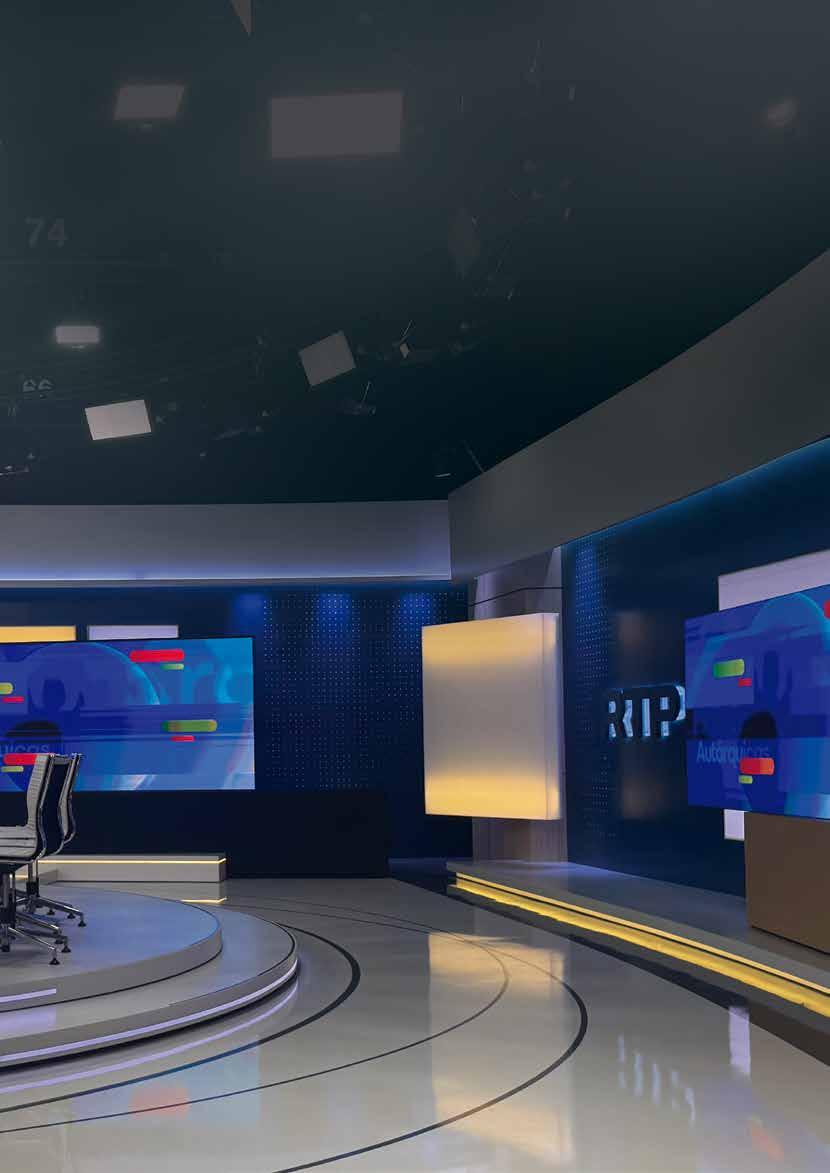
The Portuguese TV exclusively reveals its investment plans to us
drives a comprehensive modernisation: towards a more digital, resilient and secure public broadcaster
By Daniel Esparza
Portugal’s public broadcaster is advancing through an ambitious technological transformation plan. TM BROADCAST speaks with Monica Cañete Palomo, Director of Engineering and Technological Systems —and a key figure in this process— to review the milesto nes achieved so far and the road that still lies ahead
RTP is moving forward with determination in a profound technological transformation that will shape its next decade. The process, framed within the current management’s mandate and aligned with the strategies promoted by the Portuguese government, aims to modernise the broadcaster’s facilities in a comprehensive way, with a particular focus on digital transition.
It is worth outlining some general ideas to understand the scope and philosophy of this ambitious project. “The main goal is a deep modernisation of our facilities, very much focused on the digital transition,” explains Monica Cañete Palomo, Director of Engineering and Technological Systems at RTP, to TM BROADCAST. This digital transformation, she clarifies, involves evolving
towards new technologies. “We are committed to a multiplatform model and to what is known as digital first.”
In this regard, the Portuguese broadcaster seeks to redesign its traditional production and contribution models, adapting them to the new IP and streaming environments while facilitating content reuse across different channels.
“We want to share content as quickly as possible —ideally immediately— and make it easy to reuse across platforms,” Cañete summarises.
In this process, cybersecurity has emerged as a central axis. With RTP’s infrastructure increasingly based on IT, remote production, cloud editing and playout, the company has strengthened its digital protection strategy.
“We are now mixing pure IP technologies, which is why cybersecurity is becoming a fundamental area,” she points out. “In Portugal, the European NIS2 directive has just been approved, which requires critical infrastructures to meet specific obligations, and we are currently immersed in the compliance process.”
The corporation is also part of a group called ISAAC Media, promoted by the Portuguese National Cybersecurity Centre.
“It’s a specific group for media organisations, in which we participate alongside other entities from the sector. We meet every three or four months to share experiences, analyse common challenges and coordinate strategies.” This collaborative environment, she stresses, is particularly valuable to face new digital challenges with a shared vision.
In parallel, RTP is working on integrating new efficiency-driven technologies such as automation and artificial intelligence. The latter, Cañete highlights, “must be applied with special responsibility, especially in the verification of news.” Commitment to truth and public trust is a priority: “One of our key roles is to be a trusted source. We want citizens to know that if they want to check whether information is true or not, they can turn to RTP.”
In this area, the broadcaster actively collaborates with the European Broadcasting
Union (EBU), participating in projects such as C2PA for content traceability and authentication. “RTP is part of the EBU, and I’m a member of the technical committee, where we meet several times a year to make progress in these kinds of initiatives,” the technical director clarifies.
The modernisation plan also covers the technical and operational resilience of the company, with the goal of ensuring continuity of public service under any circumstances. “We want to make sure that, in case of crisis, we can continue informing the
public. When something happens, people don’t look for entertainment —they want to know what’s going on,” she explains. “That’s also one of our strategic objectives: to strengthen our resilience, both technical and operational.”


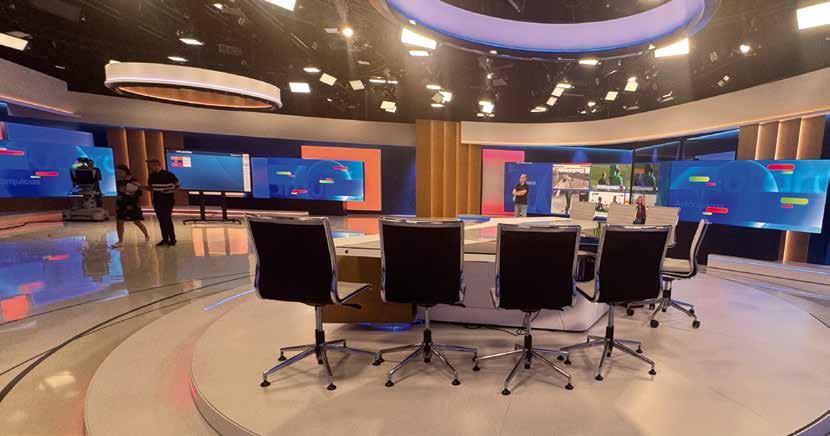
After defining the main lines of the process, RTP has completed an initial phase focused on internal reorganisation and a technical assessment of its production centres. “I came from outside, so the first thing was to understand how everything worked,” recalls Monica Cañete.
“In a company as large as RTP, the first step is to understand its structure and operations.”
During the first year, the priority was to evaluate the existing systems and identify opportunities for improvement. The process involved a thorough visit to the main sites —Lisbon and Porto— as well as the regional centres in Madeira and the Azores. “I visited each of them to see their infrastructures and workflows first-hand. The Azores, for example, have a more particular setup, while Madeira is more similar to Lisbon, though with some differences,” Cañete explains.
With RTP’s infrastructure increasingly based on IT, remote production, cloud editing and playout, the company has strengthened its digital protection strategy
That diagnostic work, she adds, “took us practically a year.”
Based on this evaluation, the team developed a multi-year investment plan to modernise facilities and renew equipment. Although partial upgrades had been made since the move to the current headquarters in 2004, a full renovation had never been undertaken.
“We have now set that plan in motion,” she emphasises.
One of the most emblematic projects is the new Casa das Notícias (as it has been internally named), encompassing the complete modernisation of all areas dedicated to news production.

“On 12 October, we launched a new visual identity for our news services,” she explains. The plan includes new studios in Lisbon and Porto, redesigned newsrooms and upgraded technical equipment. “We built a new studio in Porto, which was inaugurated precisely on 12 October, coinciding with the municipal elections,” she details. “We also opened a new studio in Lisbon —for now a temporary one— while renovation work is carried out in the permanent facilities.”
The redesign includes new sets, lighting, LED walls and an updated production control system, along with a refreshed graphics package and musical theme.
With this, RTP unveiled its new information branding, accompanied by a renewed identity: “The channel previously known as RTP3 has been renamed RTP Notícias, with a completely new visual identity.”
While the Lisbon studio renovation progresses, the editorial, editing, graphics and infographics teams have been temporarily relocated within the building. Once the works are completed, the final move will lead to a stateof-the-art news centre that will serve as the nerve centre of the organisation’s information operations. “That’s where we will make a larger investment in technology, especially in the newsroom area,” anticipates the technical director. “This project combines infrastructure, image and technology, and stands as one of the flagship initiatives of our current modernisation plan,” she concludes.
From a strictly technological standpoint, RTP is preparing to launch a public tender
to modernise its entire radio automation system, with the goal of creating a fully integrated and synchronised environment across its main sites —Lisbon, Porto, Madeira and the Azores. “In Lisbon we’re working with the latest version of Dalet, while other locations still use older versions. The goal is to standardise all systems and create a multisite architecture,” explains Monica Cañete.
After defining the main lines of the process, RTP has completed an initial phase focused on internal reorganisation and a technical assessment of its production centres
In parallel, the company is collaborating with the EBU on the redesign of its digital and multiplatform workflows, in line with the digital first model. “We’ve visited several European broadcasters to study their models, and the
EBU is providing external consultancy to help us map all our internal processes and redesign them from a transversal point of view,” she notes. “The objective is to understand how we operate today and define how we want to operate in the future.”
The next major milestone will be the complete renewal of the production and news infrastructure, including servers, automation systems and the implementation of a PAM (Production Asset Management) and BPM (Business Process Management) system to unify processes and improve workflow orchestration. “It’s a complex project —not only technically but also operationally— because it involves redesigning workflows from the ground up,” she acknowledges.
The next major milestone will be the complete renewal of the production and news infrastructure, including servers, automation systems and the implementation of a PAM and BPM system to unify processes and improve workflow orchestration
RTP is preparing to launch a public tender to modernise its entire radio automation system, with the goal of creating a fully integrated and synchronised environment across its main sites
The modernisation plan also includes a new multisite architecture that will unify the production centres of Lisbon, Porto, Madeira and the Azores under a single technological environment
Another key front is the redefinition of metadata. “Right now, since we don’t have a PAM, we manage metadata as best we can —but not in the most efficient way,” admits Cañete. “With the new system, we’ll be able to structure it properly and align with the European standards defined by the EBU.” To that end, RTP is assessing new integration methods with systems such as Avid’s BMS and MAM, within a large-scale plan that will serve as the backbone of its technological transformation.
Asked about potential convergence plans between television, radio and digital platforms, Monica Cañete acknowledges that this remains part of an internal debate as the corporation continues to modernise its spaces and systems. “At an organisational and functional level, radio and television are currently housed in separate spaces,” she clarifies.
“The multimedia area, which manages social media and digital news content, is integrated with television —specifically within the newsroom department. From there, we handle everything related to the website and social media.”
Meanwhile, the radio teams maintain independent management of their own content, although both worlds are gradually drawing closer. “With the new systems we’re implementing, we’re studying different ways to better integrate radio and television areas,” she points out. “We’ve visited several European broadcasters to see how they approach this, because it’s not easy to merge those structures. What’s clear is that we must ensure that content is accessible to everyone and easy to publish on any platform.”
The main priority, therefore, is to guarantee collaboration between teams and operational efficiency —regardless of whether radio and television remain separate organisationally.

The modernisation plan also includes a new multisite architecture that will unify the production centres of Lisbon, Porto, Madeira and the Azores under a single technological environment. “Lisbon is, naturally, the largest centre, both in staff and operational volume,” explains Monica Cañete. “But that doesn’t mean everything depends on it. In some systems, such as ENPS, there is a centralised structure, but in others, like production, that’s not the case.”
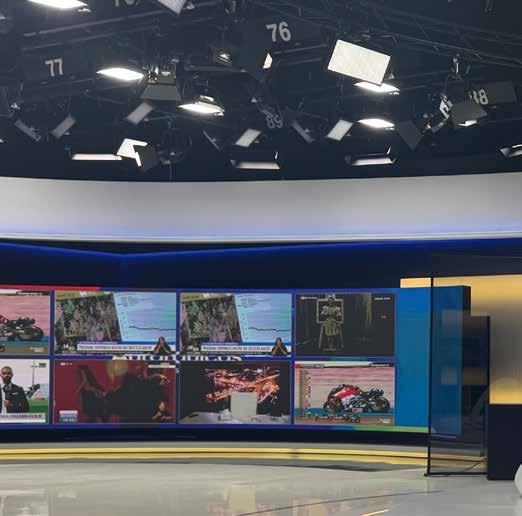
and Madeira, and plans to include the Azores in a later phase. “The Dalet video production system they use there operates completely independently.
“With the new systems we’re implementing, we’re studying different ways to better integrate radio and television areas”
The goal is to work in a networked environment, sharing resources and content. Currently, RTP already has operational systems in Lisbon, Porto
Although we already have some integrations with the Lisbon systems, we want to include it in the multisite environment once we replace the current Quantel sQ Server and Omnibus systems,” she reveals.
The process will be gradual, adapted to budgetary and human resource availability. “We don’t have infinite resources or unlimited budgets, so we need to move forward step by step,” she admits. Even so, the
roadmap is clear: to build an interconnected, digital and resilient RTP capable of operating in a network from anywhere in the country.
The company is also moving forward in its technological transition towards IP-based environments, although following a progressive and realistic approach. “When I joined, I initially considered starting with IP in the Porto project, since it was a completely new studio built from scratch,” recalls the technical director. “We analysed that possibility, but eventually realised

it was a more expensive option and also presented an additional challenge: the technical entry barrier.”
The challenge, she explains, is not only financial but also human. “Training engineering teams in IP takes time and resources. In Porto, we have fewer technical staff than in Lisbon, and although they are highly versatile teams, I preferred not to introduce a more demanding technology without strong local support,” she details. “It wouldn’t make sense to implement something that could create more problems than it would solve.”
One of the most emblematic projects is the new Casa das Notícias (as it has been internally named), encompassing the complete modernisation of all areas dedicated to news production
For this reason, RTP has decided to postpone the full transition to IP, reserving it for projects where the change would generate a tangible operational benefit. “It makes more sense to think about IP when we tackle the renewal of the playout system, which is planned within two or three years,” she anticipates. “At that point, we’ll be able to design a more complete environment, with a fully IP-based core and gateways to the outside.”
The current infrastructure, however, is already prepared to operate in hybrid mode, allowing for a step-by-step migration as studios and transmission systems are renewed. “Everything will depend on timing and budget availability,” she concludes.
In terms of image quality, the evolution towards
UHD and HDR is not currently among RTP’s immediate priorities, as the organisation is focusing its resources on other, more urgent transformations. “The truth is we have so many technological priorities to deal with that the evolution towards UHD and HDR has been pushed somewhat into the background,” admits Monica Cañete.
Nevertheless, the broadcaster already carries out some 4K recordings, mainly for concerts and special productions, using an OB van equipped for that purpose. However, the Portuguese context determines the pace of adoption. “In DTT, the situation is very different from that of other countries,” she explains. “At present, there are very few channels, and all of them still broadcast in SD.”
“It makes more sense to think about IP when we tackle the renewal of the playout system, which is planned within two or three years”
The main reason lies in the extremely high penetration of cable television in Portugal, which exceeds 80%. “Most of our audience watches RTP through cable or IPTV platforms rather than via DTT,” she specifies. As a result, the transition to 4K is limited by structural and budgetary factors.
“We would love to move forward, but there are other priorities to address first. For now, we record content in 4K that can be used on digital platforms such as RTP Play, where we can occasionally offer broadcasts in that quality.”
At the same time, the company has strengthened its graphics and set design division, focusing on
the visual integration of technology and content.
“In the graphics area we mainly work with Vizrt, which is implemented across the entire organisation,” details Cañete. In recent years, RTP has reinforced its use in studios, combining physical sets with LED screens as the main visual element in its new facilities.
The technical director recalls that in the past, the broadcaster experimented with virtual camera systems and fully digital environments, though their use was limited. “We had virtual cameras integrating 3D objects without physical sets, but in practice they were barely used,” she acknowledges. “That’s why we decided to change our approach.”
The new strategy focuses on strengthening the news graphics area, relying on Viz Multiplay and the visual power of LED walls. “The new studios combine graphics, information and video with the set design, creating a more realistic and dynamic environment,” she explains.
For now, immersive or augmented reality technologies remain in the background. “Our focus is on optimising graphic resources for the new studios and reinforcing visual consistency across the board,” she notes. The trend, she concludes, is clear: realistic, dynamic and physically tangible sets, where technology serves the storytelling.
The adoption of cloudbased technologies is another key vector of RTP’s transformation, although their use is carefully delimited. “I don’t see the cloud as a solution for archiving or for the core of our operations,” clarifies Cañete. “I wouldn’t move the newsroom system to the cloud, nor the playout, nor day-to-day operations.”
The reasons are both technical and administrative. As a public broadcaster, the corporation is subject to procurement and budgetary control procedures that make dependency on cloud
services more complex. “A provider could increase the cost of a service by 10, 20 or 50 percent from one year to the next, and in our case that might need government approval. We can’t depend on that kind of uncertainty,” she explains.
For that reason, the core operations remain onpremises, although RTP is incorporating the cloud in specific scenarios. One of these is its Disaster Recovery plan, in which Porto serves as an alternative broadcast centre. “If something serious happened in Lisbon —an earthquake, a crisis, any emergency— Porto could take over part of the broadcast and guarantee continuity of information,” she says. “We want to make sure that, whatever happens, there’s always at least one television channel and one radio station on air.”
Another area with great potential is cloud-based remote production, which is already being tested in Madeira, the Azores and Lisbon. “We’re carrying out proofs of concept with very positive results,” she comments. “This model offers greater efficiency, flexibility and cost savings. As a public broadcaster, we must optimise taxpayer resources, and cloud-based remote production is a valuable tool for that.”
The cloud also enables RTP to launch temporary channels or special event coverage with great agility. “When we need to set up a special channel for two weeks, the cloud allows us to do it quickly: a temporary cloud playout and that’s it,” she explains. “We also use it for remote commentary —commentators can intervene from outside the facilities, connecting to the central production system.”
“RTP uses AI in productivity applications and in tools that include it natively, but large-scale deployment will come with the implementation of the new PAM system”
This flexibility opens the door to hybrid automation models, where the cloud system can replace the local one in case of failure. “If something fails locally, we could switch the channel directly to the cloud,” she adds. Likewise, the cloud environment is proving crucial for managing IP contribution, transcoding and remote distribution, optimising real-time workflows.
In parallel, RTP is exploring the potential of 5G for IP contribution, particularly through transmission backpacks and private networks.
“We’ve held discussions with Portuguese operators to test private 5G networks in specific events, similar to what the BBC has done,” notes Monica Cañete. “These temporary deployments can provide great stability and bandwidth for critical productions.”
The corporation is currently conducting proofs of concept using priority 5G SIM
cards, which guarantee bandwidth and connection stability for live broadcasts. “You pay a bit more for each SIM, but you gain priority and a minimum reserved bandwidth on the network,” she explains. Combined with solutions such as Starlink, these options help reduce costs and improve operational redundancy. “An IP-based redundant contribution can even be more costeffective and efficient than traditional satellite transmission,” she stresses.
Live event production serves as a testing ground for these technologies. “Events are very important for us, especially those involving large technical deployments,” she points out. Among them, she cites the World Youth Day in Lisbon, the Portuguese Presidency of the Council of the EU, and more recently, the Volta a Portugal, where RTP tested cloud-based production and editing. “It was a year of learning.
We evaluated products, workflows and processes to understand what worked best. Based on that experience, we want to integrate some of these technologies into one of our OB vans.”
Artificial intelligence also occupies a prominent place in RTP’s roadmap. In this field, the broadcaster is moving forward steadily yet cautiously: it has defined its own ethical code and collaborates with specialised entities to ensure responsible use of the technology. “As a public broadcaster, we have an additional responsibility: we must ensure that AI is used responsibly, transparently and with full user awareness,” emphasises the technical director. “Everything must be properly documented, with risk control measures and protocols to prevent potential issues.”
“Most of our audience watches RTP through cable or IPTV platforms rather than via DTT”
Since August, RTP has been working with a Portuguese AI consultancy to audit its processes, train staff and establish risk matrices.
“Today, for instance, we held an internal training session on artificial intelligence to help our staff understand how it works, what its challenges and risks are, and also its benefits,” she explains. The goal, she adds, “is for everyone to understand the real impact of this technology and how it can be applied safely and responsibly.”
The collaboration includes creating an inventory of all assets that already incorporate AI, as well as defining a legal and technical framework aligned with European regulations. “Each use is analysed individually, risks are assessed and legal review is required before approval,” she details. In the newsroom, for example, generative AI tools are already being tested, though “in a very controlled way.”
Currently, RTP uses AI in productivity applications and in tools that include
it natively, such as Adobe plugins, but large-scale deployment will come with the implementation of the new PAM system.
“From next year, with that system as part of our wider technological renewal project, we plan to integrate artificial intelligence into workflows —particularly for tasks such as metadata management, speech-totext or facial recognition,” she reveals.
In this latter area, the company works closely with its legal department to ensure compliance with the European data protection
regulation (GDPR). “We’re carefully studying the legal aspects to make sure everything is done by the book, following European standards and best practices,” she notes.
RTP also collaborates with the EBU in traceability and content authentication initiatives such as C2PA, focused on validating the origin of audiovisual pieces. “We are actively involved in the working groups developing the standards and verification methodologies,” she explains. Although the project is still under
definition, the corporation believes this line of work will be key to reinforcing public trust in journalism and combating disinformation.
With this combination of ethics, technology and public responsibility, RTP is advancing through a comprehensive transformation process that goes beyond merely updating its infrastructure. It defines what the broadcaster’s role should be in the digital era: a modern, secure and citizen-oriented public service.


We break down the key technical aspects behind the audiovisual production of Spain’s premier cycling race, based on first-hand information from the country’s public broadcaster
Mountain stage compound
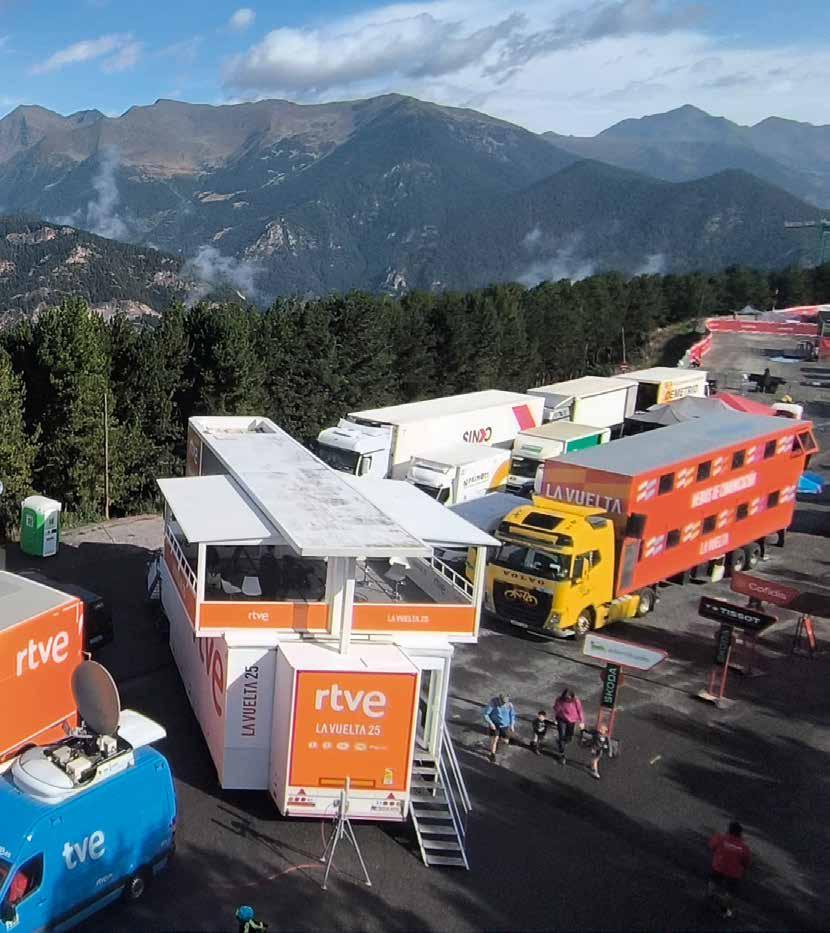
La Vuelta a España is one of RTVE’s most demanding yearly projects. The public broadcaster has been responsible for the technical
coverage of the cycling race since its inception. Coinciding with its 80th edition, TM BROADCAST visited RTVE’s mobile
production compound deployed at one of the event’s most emblematic mountain finishes: Puerto de Navacerrada, in Madrid.
There, we witnessed first-hand the effort and coordination of RTVE’s technical teams—an experience that inspired this in-depth feature, in which the broadcaster’s own professionals explain the main elements and challenges of this ambitious sports production.
The full report is available in the Spanish edition of TM BROADCAST. The following is an adapted extract for our international readers, focused on the essential technical aspects
that place this coverage on par with the world’s major sports events.
RTVE acts as host broadcaster of La Vuelta, deploying a complex production setup designed to tell the story “from within” the peloton. The coverage combines on-board acquisition (motorbikes and helicopters), air relays, ground reception, satellite uplink, and a finish-line compound with several interlinked OB vans.
The overall design pursues three key goals: broadcast continuity, image and sound quality, and resilience under changing conditions such as mountainous terrain, weather variations, and topographical challenges.
The overall design pursues three key goals: broadcast continuity, image and sound quality, and resilience under changing conditions
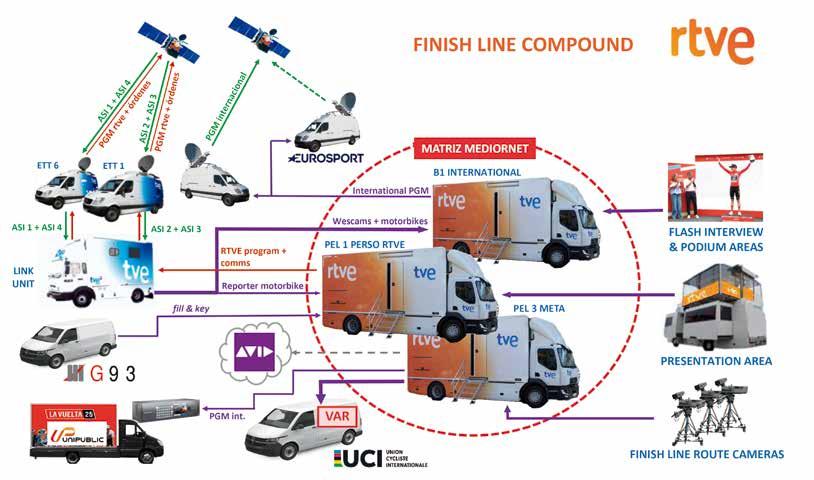
RTVE program + comms RTVEprogram+comms International PGM
Pre-production and planning
Preparations begin several months in advance and are structured around three main areas:
1. Host broadcast operational design: camera mapping, sizing of OB units, air and ground coverage, and service catalogue for third parties (official graphics, UCI VAR, international clean/dirty feeds, etc.).
2. RF architecture and site selection: 3D terrain
simulations and route analysis define follow-up sites that guarantee line-of-sight with aircraft throughout each stage. Accessibility and permits are verified on site.
3. Comprehensive testing: ground and flight trials with the full RF ecosystem (motorbikes, helicopters, aircraft), matrix adjustments, portable earth stations (ETT), video servers, and intercom systems.
Capture on the road: Motorbikes and helicopters
The narrative “heart” of the race lies in five motorbikes (one with a commentator and four with cameras) and two Wescam helicopters:
> Optics and cameras (motorbikes): 4K lenses (8.5–128 mm) for 2/3" sensors with variableangle prism stabilization to minimize vibration. The commentary bike also carries a minicamera for on-the-move interviews (e.g., with sports directors).


> Encoding and modulation (motorbikes): the HD-SDI 1080/50i signal is encoded in HEVC 4:2:2 Main10 (H.265) with low latency, MP1-Layer2 audio (128 kbps), and modulated in DVB-T2 2K QPSK (≈5.1 Mbps per stream). Wescam units transmit similarly in DVB-T2 2K QPSK (≈6.4 Mbps).
> Frequency management: each airborne or ground camera operates on a dedicated uplink frequency to avoid interference and facilitate switching.
To carry signals from the race to the finish line, aircraft orbiting above the peloton act as airborne relays:
> Tracking and pointing: aircraft belly antennas steer their beam using embedded GPS telemetry from each ground transmission.
Pilots maintain wideradius turns to avoid shadowing emitters under the coverage cone.
> Aggregated re-transmission: each aircraft aggregates and re-forwards up to seven signals over four DVB-T2 (6 MHz, 16QAM) carriers to the designated followup site for that stage, ensuring line-of-sight. A UHF repeater supports production intercom links with motorbikes and helicopters.
> Weather resilience: if an aircraft faces operational constraints, a helicopter equipped with a backup transmitter can temporarily assume relay functions.
At the follow-up site, DVB-T2 carriers are demodulated and multiplexed into
The narrative “heart” of the race lies in five motorbikes (one with a commentator and four with cameras) and two Wescam helicopters
ASI streams (four trunks ≈20 Mbps) for satellite uplink via two redundant ETTs (four 18-MHz carriers, up to ~33 Mbps).
> Cross redundancy: ASI allocation (e.g., motorbikes 1–3, motorbikes 4–5 + Wescam 1–2, duplicated in pairs) ensures that if one ETT fails, all seven sources remain available.
> Returns and coordination: the satellite link also carries programme returns and coordination orders via UHF (director, Wescam, commentary bike, etc.), minimizing decision latency.
Finish-line compound: OB vans and matrices
At the finish line, three interlinked OB vans (PEL and B1) are connected through Riedel MediorNet (25 Gb or Compact Pro stage boxes). Their typical roles:
> PEL 3 (stage finish): controls five cameras (including super slow-motion) along the
final ~400 m and handles 10 replay/2 record EVS channels. Often coordinates Wescam 2 (landscape/beauty shots).
> B1 (international feed): produces the host signal with seven own cameras at the finish (line, podium, interviews), plus PEL 3 cameras and aerial/ground signals. Networked EVS provides up to 20 record / 4 playback channels. Integrates official graphics (profiles, timing, classifications) as fill/ key from the graphics provider. Delivers the “dirty” PGM (with international stereo, English commentary, Radio Vuelta, etc.) to the event’s satellite operator.
> PEL 1 (domestic feed): builds the national broadcast with its own set (presenters, commentators) and takes the international clean feed from B1 to enrich it with local graphics and content. Sends its PGM to the links unit for DTT distribution and IP backup via FTTH.
The seven race feeds are demultiplexed at the finish-line links unit and converted to HD-SDI 1080/50i. Since each arrives duplicated over two paths, the best contribution is selected in real time— mitigating RF shadows from forests or terrain. Motorbike feeds are colormatched via remote color correctors over a dedicated Ethernet LAN. End-to-end latency from capture to matrix injection is around 600 ms.
International distribution and third-party services
As host broadcaster, RTVE provides:
> International “dirty” and “clean” signals for rightsholding broadcasters.
> Feeds for official graphics (timing), the UCI VAR system (all cameras), and venue/VIP screens.
> International audio mixes, English commentary, N-1s, and other requested formats.

Radio and multi-angle digital output
> RNE (Radio Nacional de España): commentary is produced from an onboard workspace using IP audio over 4G/5G with portable codecs (redundant RF on low bands plus LEO satellite backup). This approach simplifies operation while maintaining consistent quality in congested environments.
> OTT platform: digital audiences can access multiple live feeds (main programme and motorbike/helicopter feeds). SRT streams sent via FTTH from the finish line are decoded at the control centre, converted to baseband, and republished to CDN in adaptive profiles for multiscreen consumption.
Daily operation and workflow
Each race day follows a well-defined pattern:
1. Power-up and cabling of the compound, setup of finish-line sets and cameras.
2. Activation of the follow-up site (ETT, satellite alignment) and flight checks.
3. On-route ENG coverage for ambience/interviews, ingest and transcoding at the unit server.
4. On-air coordination between international production (B1), domestic feed (PEL 1), replays/ storage (PEL 3), and third-party services.
5. Disassembly and relocation to the next stage for overnight parking and preparation.
Resilience and design philosophy
The system relies on horizontal and vertical redundancy: dual reception chains (ETT), ASI duplication, backup paths (helicopter relay), best-signal selection at destination, unified colorimetry and control, and parallel distribution channels (satellite + IP). This design ensures continuity, signal traceability, and consistent quality across complex topographies and rapidly changing environments.
Producing La Vuelta demands a mobile architecture that blends immersive capture, robust RF infrastructure, distributed processing and switching, and multi-format delivery for both linear and digital platforms
Producing La Vuelta demands a mobile architecture that blends immersive capture, robust RF infrastructure, distributed processing and switching, and multi-format delivery for both linear and digital platforms. RTVE’s setup integrates the entire chain—from motorbike to satellite, and from there to broadcasters and OTT services—with fine quality control, low latency, and comprehensive third-party support, achieving a coverage standard fully aligned with the world’s top-tier sporting events.

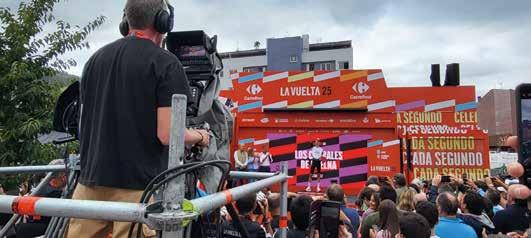

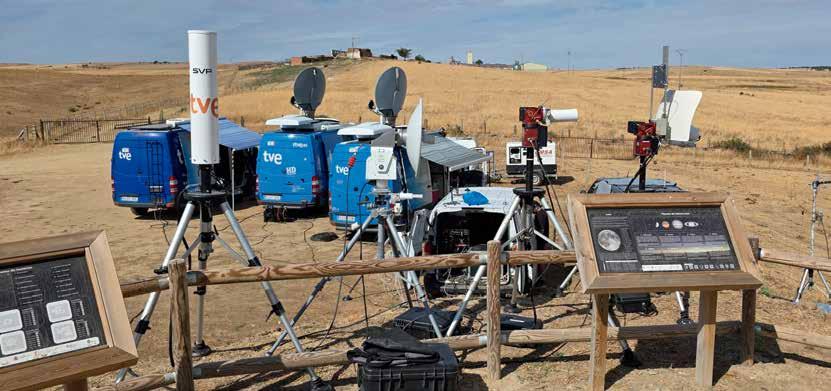


This initiative represents a step forward in the broadcaster’s exploration of 5G as an enabler for greener, more flexible production models. Amy Rajaonson, Innovation Project Manager at France Télévisions, shares the key highlights with TM BROADCAST
As part of its ongoing efforts to experiment with new contribution models, France Télévisions has recently taken part in a groundbreaking trial: the deployment of a private 5G network integrated into an aircraft to enable live signal transmission from the sky. The initiative, conducted within the framework of the IBC Accelerator “Conquering the Air(waves): from Land to Sea to Sky”, represents a step forward in the broadcaster’s exploration of 5G as an enabler for greener, more flexible production models.


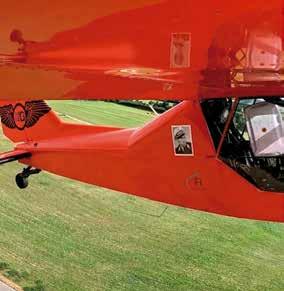
“Last year, during the Olympic Torch relay, we provided a moving private 5G bubble on land using a car,” Amy Rajaonson, Innovation Project Manager at France Télévisions, tells TM BROADCAST.
While the terrestrial experiment was successful, adapting the same concept to cycling events proved more complex. “This setup is not possible for bicycle races as they move too fast, roads are often hilly, making it difficult for a car to follow. That’s why for this type of event, transmission is usually carried out by plane and helicopter using HF.”
“The idea now”, explains Rajaonson, “is to continue our previous work on private 5G, but this time in the air, using an aircraft.
Imagine that!” In essence, the project sought to propagate a private 5G signal from an airborne platform, connecting to a ground-based transmitter and microphone — effectively creating a moving 5G coverage bubble from above.
Before getting into the technical execution, Rajaonson stresses the importance of defining the workflow and use case before any deployment.
“The important thing to begin with is the workflow and the use case, in order to determine which setup would work best,” she explains.
“When this project began, we weren’t worried about the technology, as there was no reason to think it wouldn’t work. However, the main challenge was regulation. Private 5G is still experimental, and regulators are doing their best to understand how it is being used across different industries. We must anticipate the application as soon as possible to ensure we obtain the licence in time, since validation can take a while.”
This reflection framed the entire project, highlighting how regulatory procedures can shape innovation timelines as much as the technology itself.
The project sought to propagate a private 5G signal from an airborne platform, connecting to a groundbased transmitter and microphone — effectively creating a moving 5G coverage bubble from above
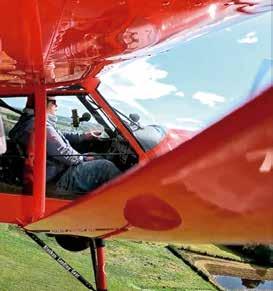
The initiative was led by France Télévisions in collaboration with Haivision, Neutral Wireless, Eutelsat, Orange, and Shure, as part of the IBC Accelerator ecosystem. Haivision coordinated the engineering alongside Neutral Wireless, which provided expertise in private 5G deployment.
“In the air, there was a POC with a tethered drone led by RAI, as well as an aircraft demonstration carried out by us”
“In the air, there was a POC with a tethered drone led by RAI, as well as an aircraft demonstration carried out by us,” explains Rajaonson. “Everyone
learnt a lot during these projects and the atmosphere was excellent.”
France Télévisions’ specific role was to select a suitable live event, manage regulatory applications, and coordinate all the stakeholders involved — including its internal sports department, production company AMP, and the IBC Accelerator team.
Testing the system in a real-world
The practical demonstration took place during the Bretagne Classic cycling race in Plouay, Brittany, on August 31st, 2025. Preparations were carried out at a nearby airfield in Pontivy, where the team fine-tuned the system before race day.
“Everything worked well,” says Rajaonson. “Our transmitter on a motorbike received successfully the private 5G signal from the sky. However, during the event we observed that the uplink connectivity was poor and our private 5G system experienced a spectrum conflict with the COFDM camera links used by the organization. Both systems had authorization to use the same spectrum, but it was handled by different regulator department.”
Rajaonson highlights two major challenges that shaped the project: time and regulation.
The Aircraft at Pontivy with the private 5G
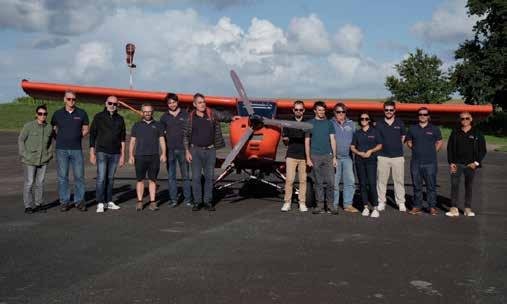
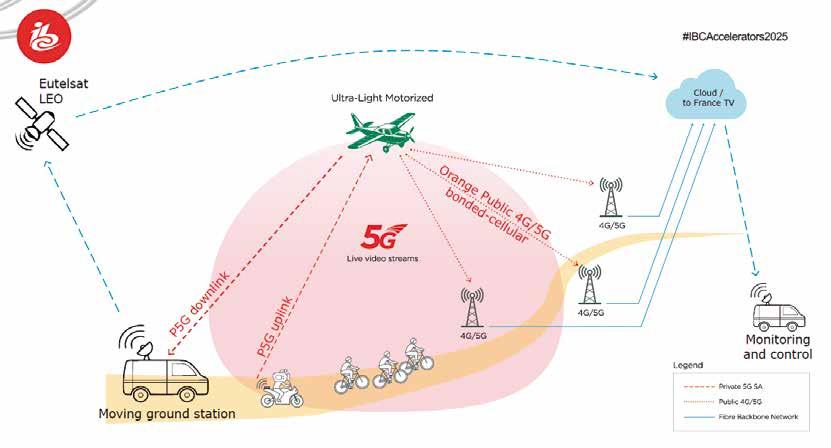
“During the event we observed that the uplink connectivity was poor and our private 5G system experienced a spectrum conflict with the COFDM camera links used by the organization”
“The project was ambitious, and it had to be completed during the IBC Accelerator process, from March to September 1st. We had many ideas and integrations, but limited time to implement everything like we imagined. For example, antenna placement and backhaul. For next step they must be optimized,” she explains.
The regulatory hurdles were equally significant.
“Typically, the n77 spectrum is used for private 5G. Thanks to this project we learnt that it isn’t allowed for aerial use, as it could cause significant interferences with radio altimeters and weather stations. We had to work with the army to borrow them their n40 spectrum,” she says.
Despite these complexities, the project proved technically sound and
paved the way for future iterations. “We can all be proud of the hard work accomplished,” Rajaonson adds.
From a production standpoint, airborne 5G opens new possibilities for lightweight, sustainable, and cost-effective workflows. “It opens us to a greener and cost-effective way of production and opens the door for us to produce contents that we didn’t cover in the past. This doesn’t concerned only sports,” notes Rajaonson.
While large-scale events like the Tour de France remain beyond the current scope of this setup — “too many broadcasters and too large a footprint,” she admits — smaller productions such as marathons or singleday cycling races could benefit greatly from such deployments.
“When comparing costs, there’s no contest,” Rajaonson explains. Private 5G solutions like this can be far more economical than traditional HF systems — but it’s crucial “to have the workflow in mind
and assess the needs to determine what is most suitable.”
While large-scale events like the Tour de France remain beyond the current scope of this setup, smaller productions could benefit greatly from such deployments
Following the live test, France Télévisions showcased the project
at IBC 2025, where the aircraft used in the experiment was displayed on-site, drawing significant attention. “People were very curious about it,” says Rajaonson. “The next step is to continue all the great work.”
With each iteration, the broadcaster continues to refine its understanding of how private 5G networks can complement or even replace conventional contribution models, further exploring their potential in live production workflows.


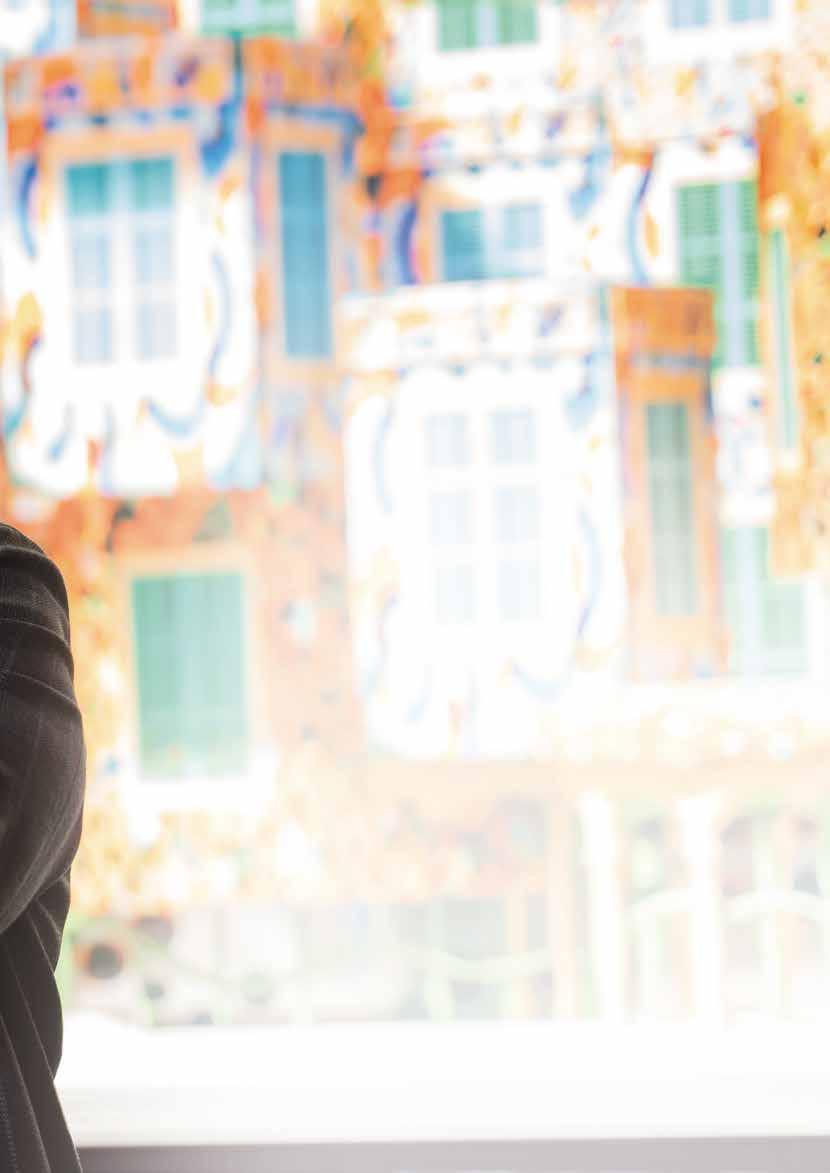
a waiting list and a new temporary structure for 2027
“We’ll be completely sold out for the 2026 show,” anticipates the Managing Director of Integrated Systems Events in this new instalment of Industry Voices in TM BROADCAST
By Daniel Esparza
Steady growth — that’s how the evolution of Integrated Systems Europe (ISE) could be defined in recent years. With just a few months to go before the next edition (3–6 February 2026, Barcelona), the show’s management anticipates a new record in participation.
“The show is already 5% larger than it was last year, and we still have many exhibitors whose contracts are in process. So, we anticipate exceeding the 1,600 exhibitors we had in the previous edition,” explains Mike Blackman, Managing Director of ISE, in this new instalment of Industry Voices, the section of TM BROADCAST that gathers some of the industry’s most influential voices.
Among the segments driving this growth, Blackman highlights the live events sector: “Many companies that hadn’t participated before have now committed, and all the leading brands are on board as well.”
This upward trend has led the organization to start
planning some changes for the 2027 edition, which Blackman shares with TM BROADCAST ahead of time. The Managing Director of ISE foresees the need to establish a waiting list that year and reveals exclusively that the team is already working on obtaining permissions to install a temporary new structure, given that the opening of the longawaited Hall Zero has been postponed until 2028: “We expect to have confirmation within the next few weeks and are optimistic about securing the additional space we need”.
Below, the full conversation:
First, as Managing Director of ISE, I want to ask you about your expectations for the upcoming edition.
Well, we’re already growing. As of today, we have over 1,400 confirmed exhibitors — and we still have four months to go. The show is already 5% larger than it was last year, and we still have many exhibitors whose contracts are in process. So, we anticipate
exceeding the 1,600 exhibitors we had in the previous edition.
“For broadcast professionals, the potential partners you could meet are also at ISE. So, it’s a great opportunity to see what’s new in the sector and what technologies you can apply to your own workflows”
The most significant growth has been in the live events section. Many companies that hadn’t participated before have now committed, and all the leading brands are

on board as well. So, we’re seeing tremendous expansion in that sector. Overall, the show is growing strongly.
I anticipate that we’ll be completely sold out for the 2026 show, and that in 2027 we might even have a waiting list.
One of the highlights of the next edition will be the Cybersecurity Summit — a topic that’s generating growing interest. What led you to create this new space, and what are your main objectives with it?
One of the key things that happened was that, after several discussions with the Spanish cybersecurity agency and various
security services, they highlighted how significant this topic has become. While cybersecurity has been touched upon in some ISE conferences before, we hadn’t placed such a major focus on it until now.
Since we made the announcement, we’ve seen multiple incidents that have reinforced our decision — the hacking of Heathrow Airport, airline systems going down, and other major disruptions. These are significant because they involve audiovisual technologies. So, we said, “Okay, we already knew it was important — now we have the evidence of why.”
It’s also making customers ask integrators and manufacturers new questions: “If we work
with you, how secure is our system?” So, we need to highlight that and remind both attendees and exhibitors: you may already be dealing with cybersecurity, but you need to stress its importance and be ready with the answers your customers will ask for.
Another key addition is Spark, focused on innovators in the audiovisual world. What will be its main attractions or differentiating features?
The main reason we started Spark is because ISE has become the platform where you find technology and solutions for content creation — and we’ve started to see more and more content creators walking the show floor.

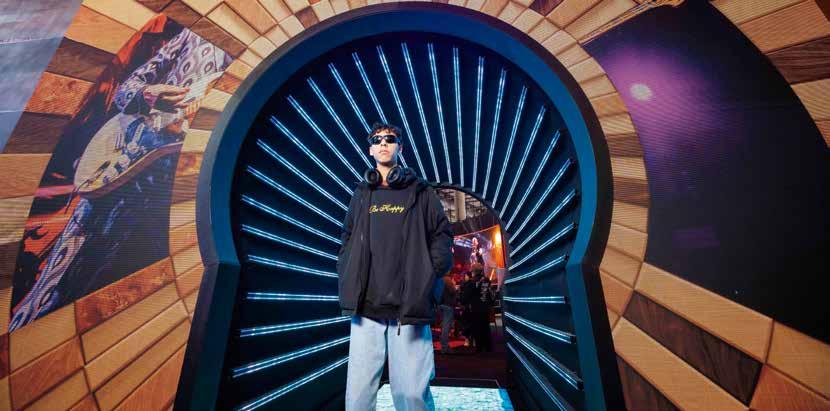
From game-developers and VFX specialists to set designers and studio managers, they’re all coming to see what’s available for them.
Now some of them, such as Mediapro and TV3, have started exhibiting. More and more of these professionals are saying, “We want to show our customers what we can do with these solutions,” instead of just walking them around to see other manufacturers.
So, the demand was clearly there. What was missing was a dedicated space within ISE for them. After discussions with manufacturers and associations, we decided to create Spark to meet that need.
“Based on current projections, we expect to have more demand for space than we can accommodate, meaning there will likely be a waiting list in 2027”
Following what you said about the emergence of new exhibitor profiles, to what extent does attracting new audiences — particularly first-time visitors — fit into your overall strategy?
Part of our overall strategy is to bring together the entire AV ecosystem. When we look at how content creation is evolving, we see big changes.
In the past, a TV studio might have occupied a warehouse-sized space, used only for one weekly
show — meaning it stayed empty for six days. The shift to digital studios has made them much more flexible, allowing multiple formats in the same space. Studios have also become smaller, giving rise to micro-studios.
At the same time, many companies producing corporate videos or internal communications for staff and clients are now creating content in-house. They’re looking for solutions, ideas, and partners to help them. That’s exactly what’s driving Spark — a space where they can find those answers.
TM BROADCAST is a magazine focused on broadcast professionals. You’ve mentioned TV3, Mediapro, and other companies. What arguments would you give to encourage a broadcast professional to attend ISE?
Firstly, the nature of broadcast has changed — it’s moving closer to the AV sector. If you’re looking for virtual studio solutions or other essential equipment for production, most of it can be found at ISE, often in its latest versions.
“We have a three-year rolling contract, which means we’re committed to Barcelona for at least the next three years — and every year that commitment extends another year”
For broadcast professionals, the potential partners you could meet are also at ISE. So, it’s a
great opportunity to see what’s new in the sector and what technologies you can apply to your own workflows.
To what extent do you think a trade show like ISE contributes to the ongoing convergence between the broadcast and audiovisual worlds — one of today’s hot topics?
Well, “convergence” really is the right word. There are now more and more AV solutions available for broadcast and content creation. For many broadcast professionals who’ve been in the industry for years, ISE is a place to discover new ideas and technologies — to be inspired and creative again.
Let’s talk about the current global context — the uncertainty and commercial restrictions. How can this affect a trade show like ISE?
We’re certainly seeing how trade restrictions impact the industry. For example, some manufacturers who used to exhibit at North American shows may now
be limited or prefer not to present their products there.
Since ISE takes place at the beginning of the year, it’s perfectly timed for product launches — so it’s still the ideal place to see what’s new. Of course, global trade is constantly changing — sometimes weekly — depending on political decisions, particularly in the US.
Previously, some Asian products were highly competitive in North America, but tariffs have changed that. As a result, many companies are now focusing more on Europe as a key market, which might even lead to better offers here. It’ll be interesting to see how that develops.

There has also been discussion about the new Hall Zero, whose opening has been postponed until 2028. You’ve expressed full understanding of the situation — but to what extent does this affect your plans for the coming years?
It will certainly slow our growth in 2027. Based on current projections, we expect to have more demand for space than we can accommodate, meaning there will likely be a waiting list that year.
We’re actively exploring alternative plans, including the exciting possibility of building a temporary structure next to Fira Gran Via. We expect to have confirmation within the next few weeks and are optimistic about securing the additional space we need.
Looking ahead to 2028, Hall Zero will allow us to implement some exciting new ideas we’ve been working on. Having extra time lets us refine those concepts — and that will make the new hall even more exciting when it finally opens.
You’ve also emphasized your strong relationship with Fira de Barcelona and your commitment to the city as the show’s venue. Can we take this as confirmation that there are no plans to relocate the exhibition in the coming years?
We have a three-year rolling contract, which means we’re committed to Barcelona for at least the next three years — and every year that commitment extends another year.
On the postponement of the new Hall Zero until 2028: “Having extra time lets us refine those concepts — and that will make the new hall even more exciting when it finally opens”
Our community and our industry are coming to Barcelona in greater numbers from all over the world, and that’s the clearest sign of support. As long as that commitment from the industry continues, ISE will stay in Barcelona.
Finally, from a broader perspective, what would you say truly sets ISE apart from other international trade shows in the audiovisual industry?
Size, first of all. We’re the biggest AV show in the world — more than twice as large as any other. That means more opportunities to see new products, meet people, and discover ideas.
But it’s not just about scale — it’s also about innovation. We consistently encourage exhibitors to present new products and ideas, and we’re ahead of the curve when it comes to thought leadership. The keynote speakers, the conferences, and the knowledge shared at ISE help people understand
what’s next — and, more importantly, what it means for their business.
“We’re the biggest AV show in the world — more than twice as large as any other. That means more opportunities to see new products, meet people, and discover ideas”
Is there anything else you’d like to add to be included in the interview?
Yes — please, come to ISE! We look forward to welcoming you there. Visit our website, www.iseurope.org, to register — and of course, you can also get a free code from TM BROADCAST for free access to the show.
So, make sure to check TM Broadcast’s website as well to get your complimentary code for ISE 2026.
TM BROADCAST readers can register here for FREE using the code ‘tmbroadinter’

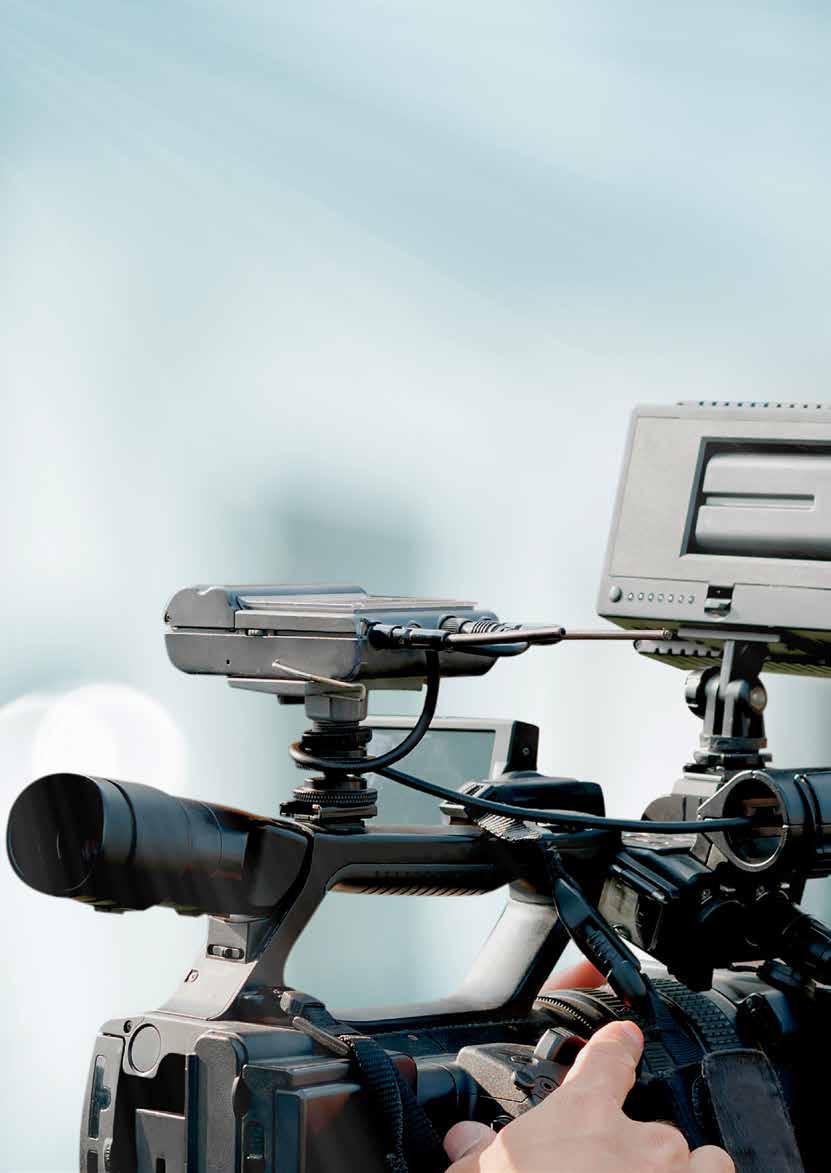

The stage of doubts, errors and interferences is well behind us. Wireless video monitoring in real time has become a practically essential, pretty fashionable solution featuring simple configuration and easy operation, which can be summarized in four actions: turn on, pair, transmit and display
By Carlos Medina, Audiovisual Technology Advisor
Wireless systems in the audiovisual sector, especially in audio, are a reality that is clearly well established in the workings of this industry. But in the field of video, it has taken a little more effort for professionals to make use of these solutions for live work. We were more conservative and opted for a good cable run and a broadcast connection system.
Clearly, things have changed for the better. At present, real-time wireless video monitoring moves forward with a series of parameters that have allowed its expansion and success in the audiovisual and live sectors, as well as in the field of security
and video surveillance, drones and robotics, or for industrial and emergency/ rescue applications.
When making reference to a real-time wireless video monitoring system we are including many details and solutions that we need to know and understand. First of all, we need to distinguish what elements are included in these systems:
1. TX or transmitter. It is the piece of equipment in charge of converting and sending mainly the video signal wirelessly. We can find a separate TX module or also a video monitor with a built-in TX (which allows us to view the video and send it at the same time).
2. RX or receiver. It is the device that receives the wireless signal sent by the TX.
3. Monitor or recorder. It is the destination equipment for the signal received by the RX. We can also include any type of display, control station or monitoring software (OBS, vMix, NDI Monitor, etc.).
Wireless video monitoring can be unireceiver or multireceiver (simultaneous), and each of the existing solutions works under Wi-Fi technology, RF technology or the manufacturer's own protocols (a wireless private network -point to point or mesh-). In addition, some kits allow remote/IP/ Internet streaming.
The most basic and simple operation to understand these systems involves, for example, a TX being connected via HDMI or SDI to a ‘main’ camera. The TX converts and sends the video signal wirelessly both to a receiver (RX) -which, connected to a monitor allows viewing the received
video or other use- and also to a recorder, in order to store this video output. It can be a kit comprising several RXs, which allows to have more users interconnected wirelessly.
Wireless video monitoring can be unireceiver or multireceiver, and each of the existing solutions works under Wi-Fi technology, RF technology or a manufacturer's proprietary protocols. In addition, some kits allow remote/IP/ Internet streaming
It's now time to learn a little more about some important parameters and specifications for a good choice tailored to production needs where real-time wireless video monitoring is needed:
Nowadays, the most standard connections for TX equipment (outside the wireless field) are
made through BNC and HDMI connectors, thus enabling to share video signals as the main output along with others such as: tally signals, TC, triggers, RS485/RS422 control protocols, among others.
In the case of the RX, to these two physical connectors a USB-C output is added to directly connect the receiver to a Smartphone or tablet and achieve a smooth, stable monitoring (supporting UVC protocol). Another option is having an RJ45 port so as to be able to use Stream RTSP to stream video directly to live platforms such as Zoom, YouTube, Twitch or TikTok along with other IP protocols: NDI|HX, SRT, RTMP and HLS.
The most common types are: Wi-Fi 6, 2.5GHz/5GHz/6GHz, LTE/5G, or low-latency dedicated RF links based on closed point-to-point systems (from manufacturers such as Teradek, Hollyland, Vaxis...).
Some wireless transmission kits work with bonding technology (transmission with an added link) that allows the aggregation of different network connections (for example: 3 4G connections, Wi-Fi and Ethernet. This technology maximizes transmission stability and prevents transmission interruption, automatically redistributing traffic in the event of a connection being lost on one of the networks.
It is important to note that regulation within the European Union and Spain may limit the maximum transmitted power (EIRP) between TX and RX, so the manufacturer may declare that their kit is high emission/
transmission power (dBm) despite exceeding the legal limits. It is convenient to find out the support ("country code") for Spain/European Union regarding the legal transmission power.
› TRANSMISSION CAPACITY. We refer to the number of RXs with which you can simultaneously work for each TX, regardless of transmission protocol. In 2025, the most advanced solution supports up to 6 simultaneous receivers.
› LINK TYPE. There are four types: point-to-point (one TX to one RX); pointto-multipoint (one TX to several RXs); bidirectional (interactive TX/RX with remote control); and multi-device (mobile RX with apps or tablets).
› TRANSMISSION RELIABILITY AND STABILITY. Each kit has developed internal systems to prevent wireless connectivity failures and allow real-time feedback on frequency status, ensuring an uninterrupted, reliable and more rewarding experience.
For example, DJI through its SDR (Software Defined Radio) technology supports seamless automatic frequency hopping in on 2.4 GHz, 5.8 GHz, and DFS (Dynamic Frequency Selection) frequency bands. In the event of experiencing an interference, it can automatically switch to the smoothest channel when operating in complex environments with many obstacles.
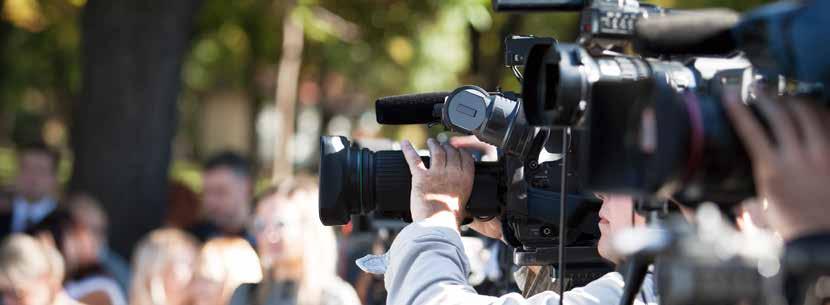
Also, well-known brands such as Hollyland have implemented their own Auto Dual-Band Hopping technology (2.4/5 GHz) with automatic frequency switching; Teradek, under the Zero-Delay patent; or Kiloview, with Kilolink (on-premises or in the cloud) through bonding technology.
In addition, each manufacturer provides the possibility of establishing different specific configurations between TX/RX for greater optimization in transmission by tweaking
parameters such as signal quality (resolution/ FPS) and/or effective bitrate (from 60 Mbps to 3 Mbps), thus adapting to the relevant workflows of broadcast, streaming, multi-camera production or shooting direction.
Also known as reach, range, or transmission distance. Here we are making reference to a direct and clear path between the TX antenna (camera or video source) and the RX antenna (monitor, recorder, control station).
It is important to make a distinction between declared reach and effective reach. Declared means that information published by the manufacturer on the LOS of a specific model, always under ideal, optimal conditions, permitted legal power, correct alignment between TX-RX and the absence of obstacles and interference.
On the other hand, the effective range is the most realistic distance supported by the TX-RX kit under the specific conditions of each

work situation (indoors, outdoors and considering any physical obstacle as well as weather conditions).
We can find a fairly broad field of declared reach, from 100 meters to 3 kilometers, the most common figure being 1,000 meters. And there are even kits that allow the optional configuration of selecting the desired range for line of sight.
Of course, the effective reach is different and always lower than the declared figure. Physical obstacles reduce both range and signal quality, such as: walls, people, trees, metal, smoke, heavy rain,... which can cause decreased signal power, potential pixelation, greater latency, interference and/or a temporary loss between TX and RX.
› LATENCY. It is the total time it takes for a signal or data to go from TX to RX, provided a stable display result without visual compression is achieved. It is measured
in milliseconds (ms) or seconds (s), and determines how “live” the image you see from end to end of the wireless video setup is.
A distinction should be made between declared and practical or actual latency, resulting in different data in terms of total time, as was the case with the range of distance. In real-world scenarios (obstacles, interference from other signals, congestion...) latency usually increases.
Manufacturers talk about ‘zero delay’, ultra-low latency or low latency solutions or kits. For example, some latency data to consider based on production requirements: <1 ms for high-end cinema, specifically in situations very sensitive to delay (focus tracking -focus puller-, use of remote viewfinder, synchronization with audio/lip sync, etc.); 10-60 ms for director or production monitor; and >60 ms in streaming productions or secondary monitoring.
Distance/range, latency and image quality are key factors to classify the different monitoring solutions for the production environment
› RESOLUTION. We refer to image quality in terms of the number of horizontal and vertical pixels, where UHD and 4K kits can be found and 1080p (FHD) as the resolution mostly used.
In regard to this parameter, it is essential to know the video output format with concrete technical specifications such as color depth (8-bit, 10-bit, 12-bit...), the type of video signal sampling (4:2:0, 4:2:2, 4:4:4,...), frame rate, SDR/HDR and compression codec (H264/AVC, H265/ HEVC, MJPEG, MP4...), which places the wireless video transmission kit at the most professional level (cinema and broadcast), or for portable or streaming solutions.
› COMPATIBILITY and INTEROPERABILITY.
Real-time wireless video monitoring kits have to work seamlessly with any capture and playback/presentation/ recording equipment to be successful within the professional sector. Therefore, video signal coding and connectivity protocols are the same as those already used in the field of cinema and broadcast (SDI-3G, SDI-6G, SDI-12G, HDMI...) regardless of the type of camera (DSLR, mirrorless, digital cinema, ENG, PTZ, EFP...), mixer, monitors or external recorder.
In addition, some manufacturers maintain compatibility between the different generations of wireless video monitoring models being released on the market. A very beneficial option for investments in the purchase of equipment and for making the most from its use. This is what we call interoperability.
› SECURITY. We refer to working with AES-128/256 encryption,
authentication, VPN private networks, free channel selector and spectrum analysis.
› POWER and BATTERY DURATION. Most kits have the option of NP, V-Mount and Gold-Mount batteries, external DC power or USB-C (allowing fast charging -PD Fast Charging- and are compatible with many modern power banks).

In each country, 5 GHz, 6 GHz or other bands are regulated in various aspects. Thus, we can find that a kit works very well in the US but finds itself limited in Europe
Also worth of note are other extras such as: transmission of camera metadata, very important within the field of cinema between directors, operators and DIT with ARRI and NETWORK cameras; the voice call function favoring real-time, direct, one-to-one communication
between the receiver and the transmitter; the switching of TX source in the RX allowing to monitor several TXs; the recording on SD or USB card on the RX with automatic file organization; camera/ stabilizer control (PTP -Point-to-Point-) control, the wireless transmission technology that makes it easier to control some camera functions directly from an app, adjusting parameters such as opening, shutter and ISO and even activating the camera's photo and video recording functions; or having conventional monitoring assistance tools such as LUTs, Peaking, WFM and False Color, thus offering a clearly professional monitoring experience.
Last but not least are: on the one hand, mounting of TX/RX within the professional context and

tailored to the solutions already implemented in each work area with compatible shoes and mounting plates (standard thread of ¼"-20 or 3/8"-16, "shoe" type, or clamp, V-mount...) or integrated/ modular assembly; and on the other hand, the manufacturing design of the TX/RX being light, resistant, optimized in terms of consumption, passive cooling and as quiet as possible.
2025 presents innovations and new trends that we must assess calmly as they are being gradually implemented: use of optical systems (laser/Lefia) capable of transmitting video without compression with ultra-low latencies in nanoseconds; more software systems (encoders/decoders, stream managers, cloud/ edge multiviewers) enable routing, scaling and
applying AI (retranscoding, event summary) on lower latency routes; or platforms that allow subscription features to be activated (edge AI, multi-camera, remote MAM).
Each of these parameters and aspects have an impact, but mainly the distance/range, latency and image quality are key factors when it comes to classify the different monitoring solutions available to the production environment:
› High-end or professional. Its domain is film production and the broadcast environment, between the main shooting camera and the needs of the shooting set.
› Mid-range or semi-professional. More frequent in multi-camera production, hybrid production, outdoors and events.
› Low range or amateur. Very significant in the field of portable production, small sets and streaming on live social media platforms.
Nowadays, versatility, portability, stability and high sensitivity/ precision are the great advances that wireless video transmission kits have experienced
When it comes to choosing one or another kit, it is convenient to know the choice of parameters offered by each manufacturer. But price is key, given the existence of different solutions to be used, the most expensive being high-end ones (cinema and broadcast) and the cheapest the ones dedicated to portable or streaming environments.
In each of the abovementioned production environments, it is very convenient to design a wireless video transmission solution that includes use of redundant signals, implementation of ultradirectional gain antennas (panel, ‘cloverleaf’ or helical) as well as backup links and spectrum analyzers to minimize the existence of errors, cut-offs and interference.
Despite the dominance and expansion of Teradek and Hollyland in the audiovisual, broadcast, film and live sectors, there are other companies that have developed very representative and competent models:
› Teradek: Volt 6 XT / LT / Monitor Module / Ace 750 / Ranger Series
› Hollyland: Pyro5 / Pyro 7 / Pyro H / Mars 4K / Cosmo C2
› Vaxix: Storm 3000 DG / Storm 1000XR
› Accsoon: CineView 4K / M7 / M7 Pro
› Atomos: Shinobi 7 RX
› Swit: CREW 1.2km/3km MAX
› DJI: SDR Transmission (O3 Pro)
› Kiloview: P3 Mini
› Cinegears: Ghost-Eye 800M
› Lilliput: WS500
› Krieg: TR-10
› Dejero: EnGo 3x, 265, 263
› LiveU: LU900Q / LU810
› TVU Networks: The One
Other manufacturers with a lower market share but very important to take into account for tighter budgets are: Smallrig, Eliview, Camtronics, Feel World, Mqv, Godox, Lensgo, Rode, Saramonic, Zhiyun, Smallhd, Dwarfconnection or Wooden Camera.
All solutions and kits have made it possible to achieve freedom in video connection without cables. Wireless real-time video monitoring systems are one of the most widely used pieces of equipment for film directors, or Focus Puller / 1st AC, Video-assist, DIT station, recorder, mixer or customers who need to monitor the live signal in demanding shootings, live events, streaming, professional video production, multi-camera to reference monitors, recorders, control stations and/or on live social media platforms.
We cannot conclude this article without mentioning the legal aspect that covers spectrum regulation. For example, in each country the 5 GHz, 6 GHz or other bands are regulated in
aspects such as: allowed for free use, with DFS restrictions, maximum power, channels allowed... Thus, we can find that a kit works very well in the US but their performance may be limited in Europe or Spain under different regulations.
In Spain, the regulation of radio spectrum frequencies, which include real-time wireless video monitoring systems, is mainly the responsibility of the Secretary of State for Telecommunications and Digital Infrastructures of the Ministry of Economic Affairs and Digital Transformation. The basic regulatory framework is the National Frequency Allocation Table (CNAF), approved by ministerial order that defines which frequency bands can be used in Spain. In addition, the National Commission on Markets and Competition (CNMC) performs a supervisory/ regulatory role in the field of telecommunications.
The “2033 Wireless Video Streaming Systems Market Research Report”
(source: https:// growthmarketreports. com/report/) portrays an increasingly broad and diverse market in applications such as broadcasting, surveillance and security, commercial, industrial, residential, and other specialty uses.
Nowadays, versatility, portability, stability and high sensitivity/precision are the big advances that wireless video transmission kits have experienced, either under Wi-Fi, RF technology or manufacturer proprietary protocols.
Professionals for AV and broadcasting are well aware of the benefits of working wirelessly, but under implemented and tested solutions to ensure that the results are the best.
We already left well behind the stage of doubts, errors and interferences. Wireless video monitoring in real time has become a practically essential, pretty fashionable solution featuring simple configuration and easy operation, which can be summarized in four actions: turn on, pair, transmit and display.
